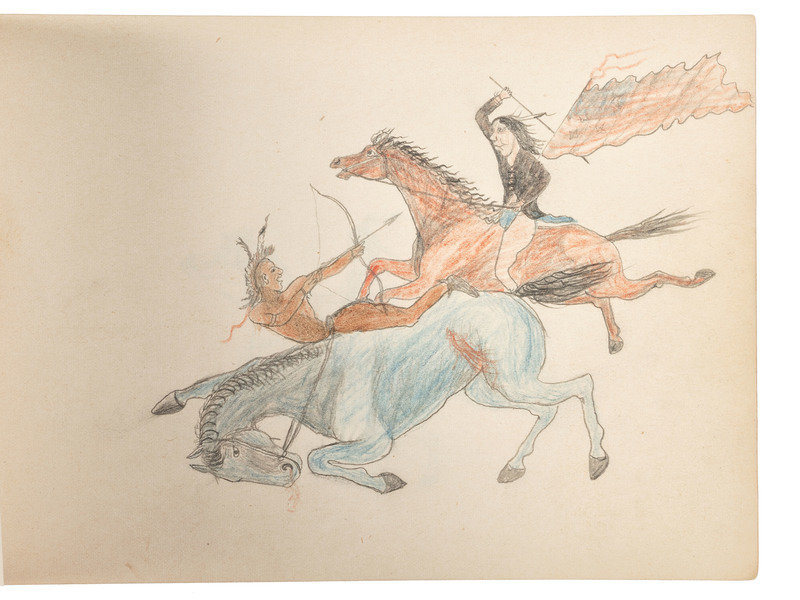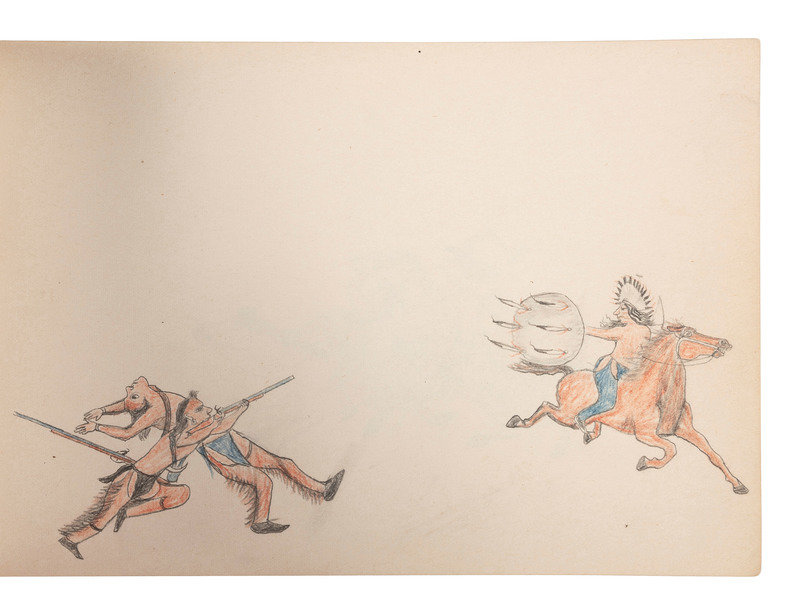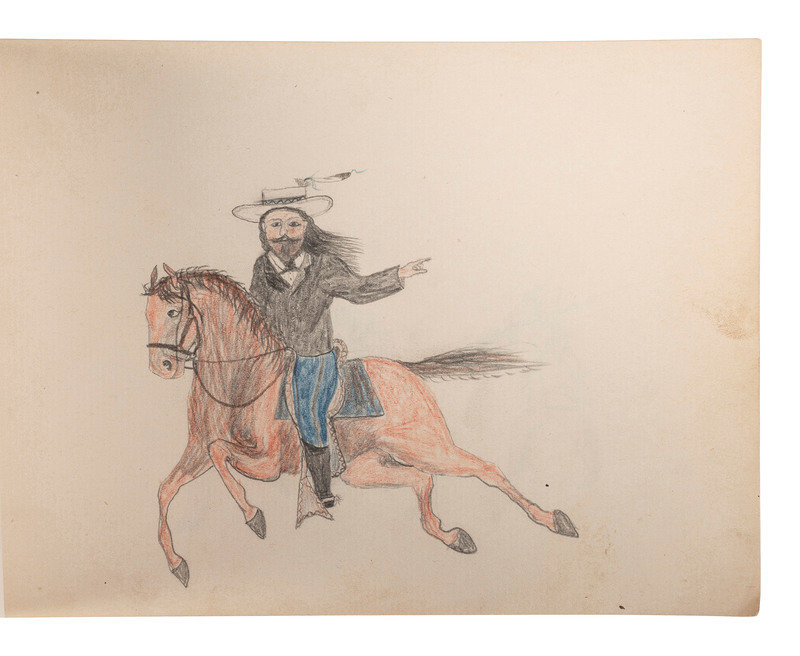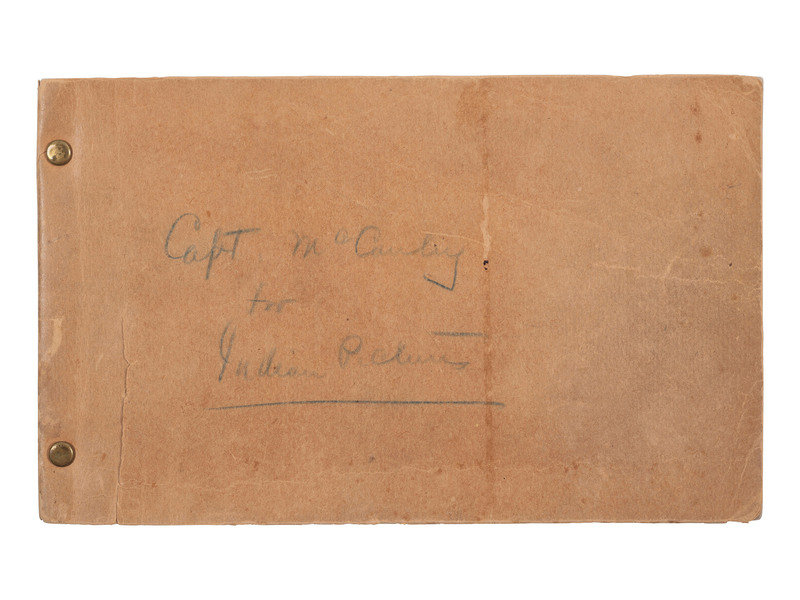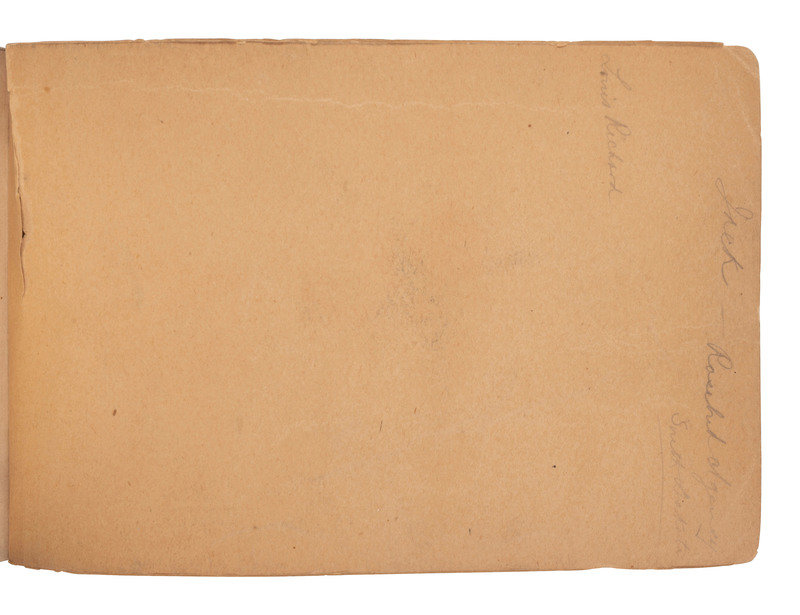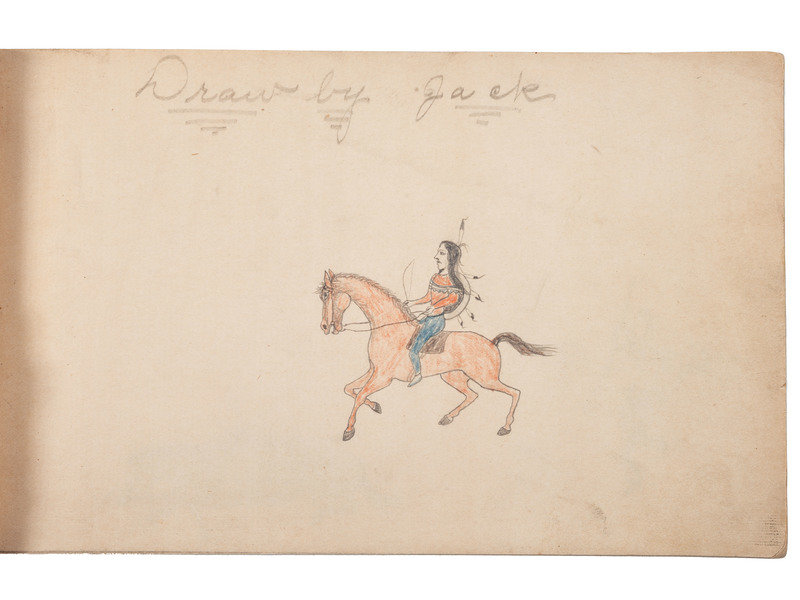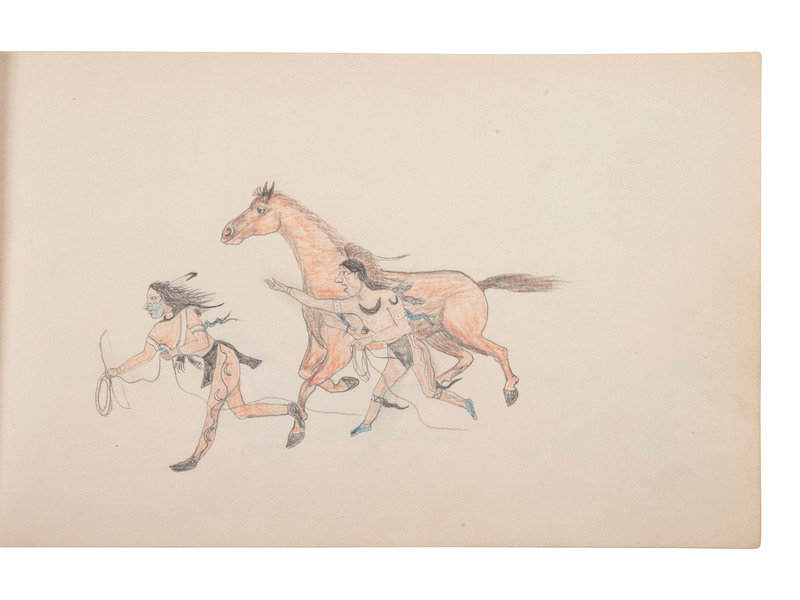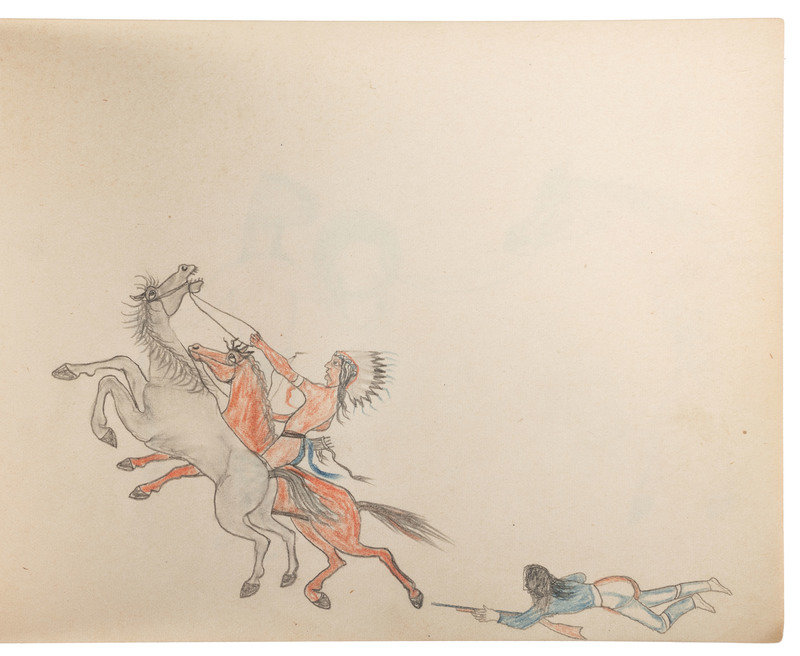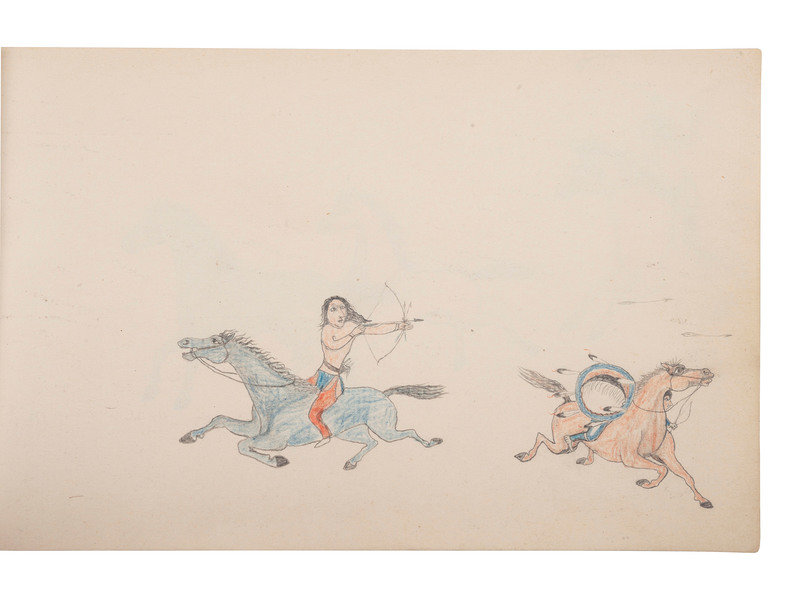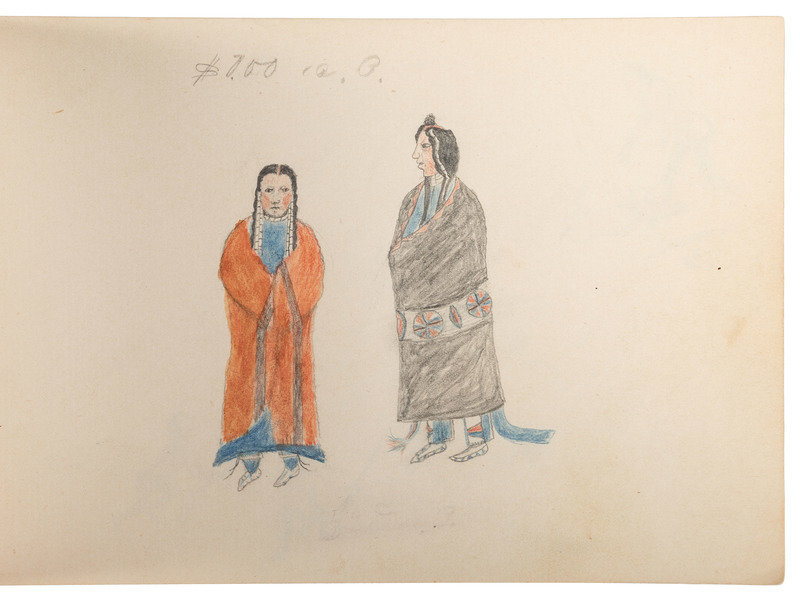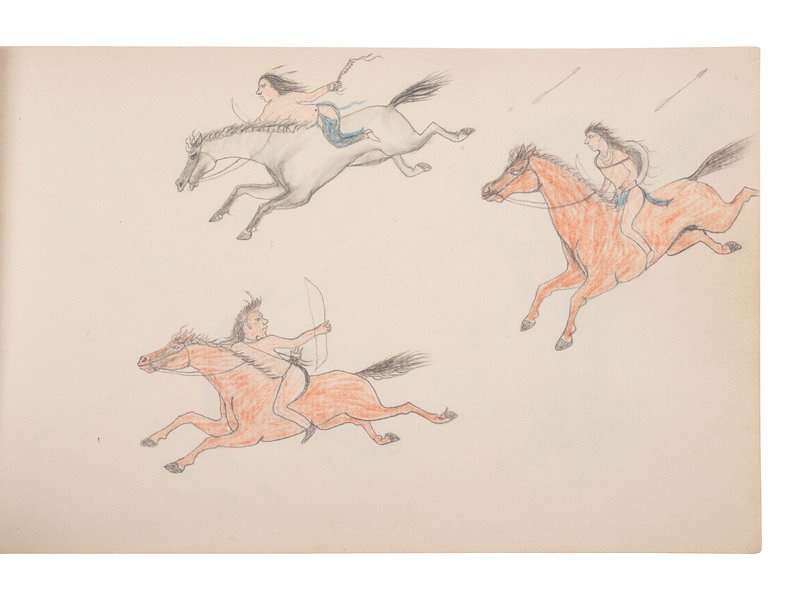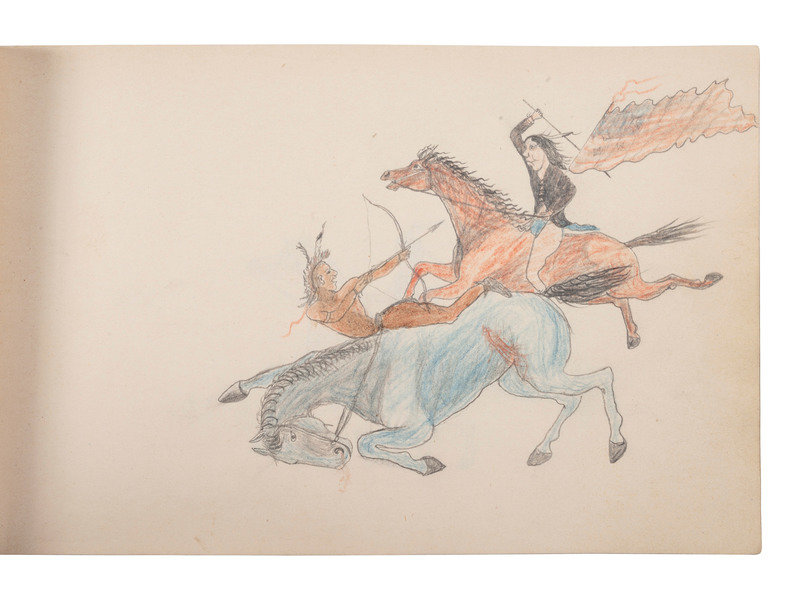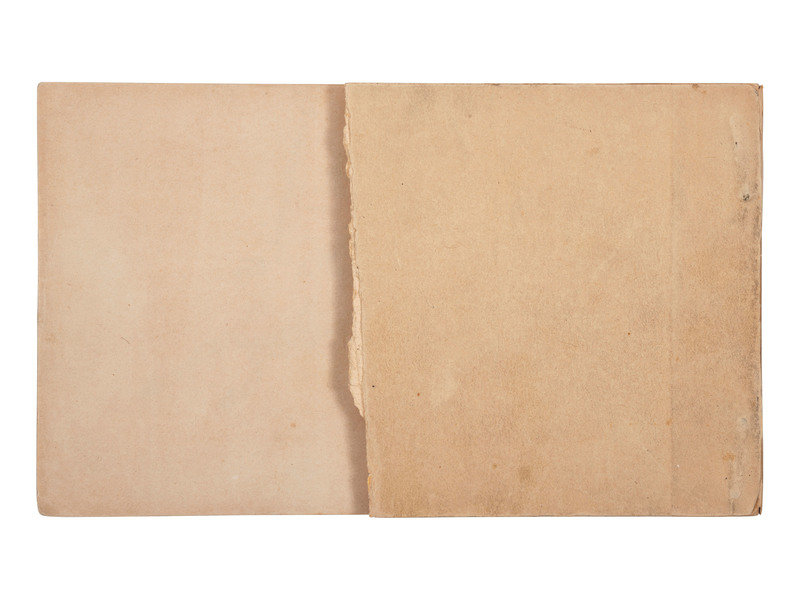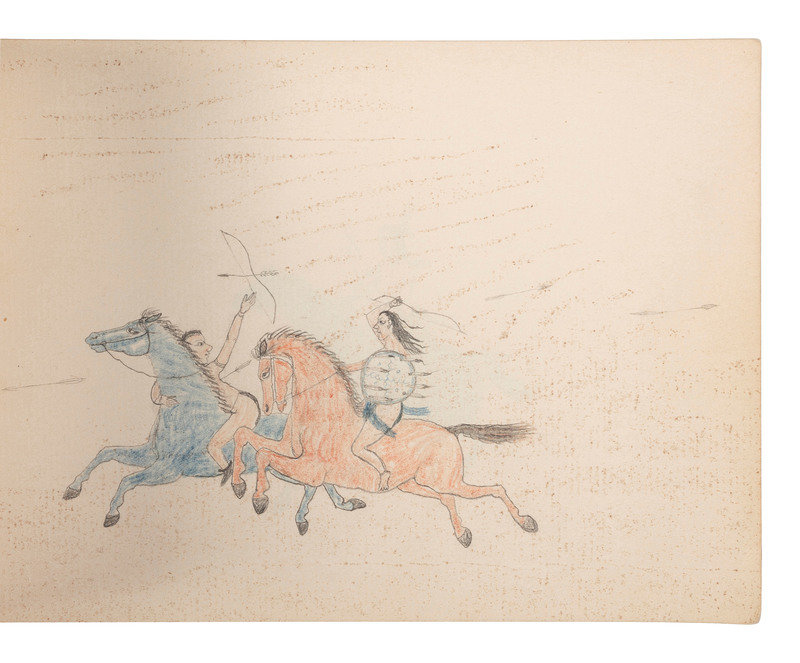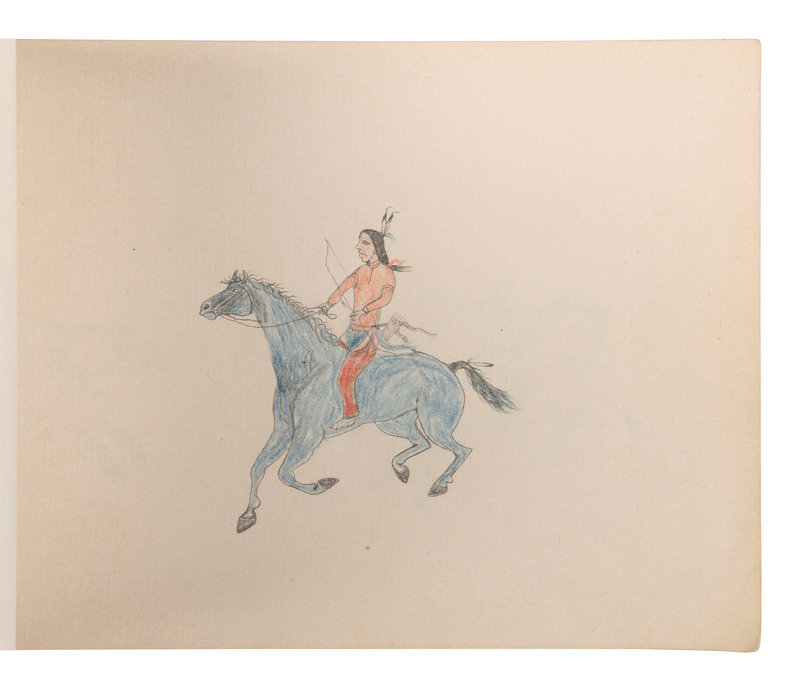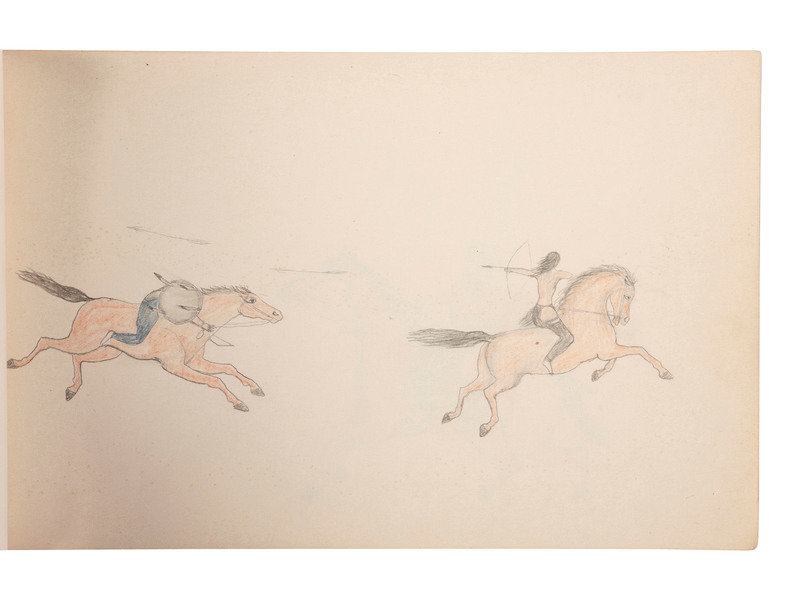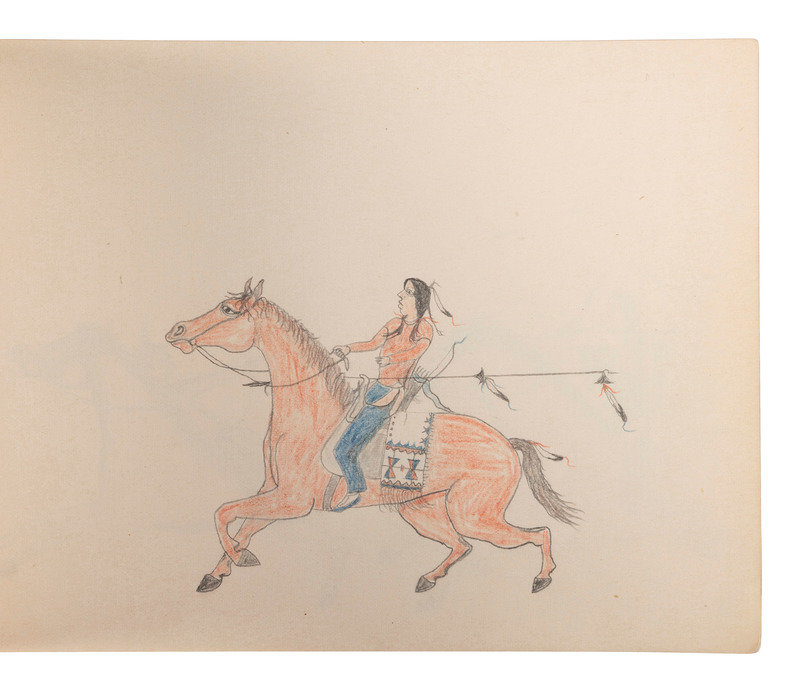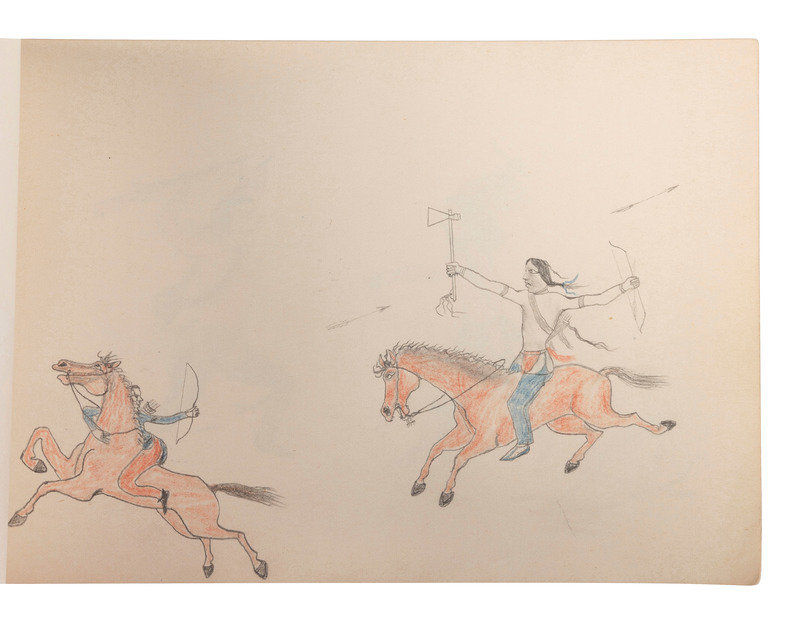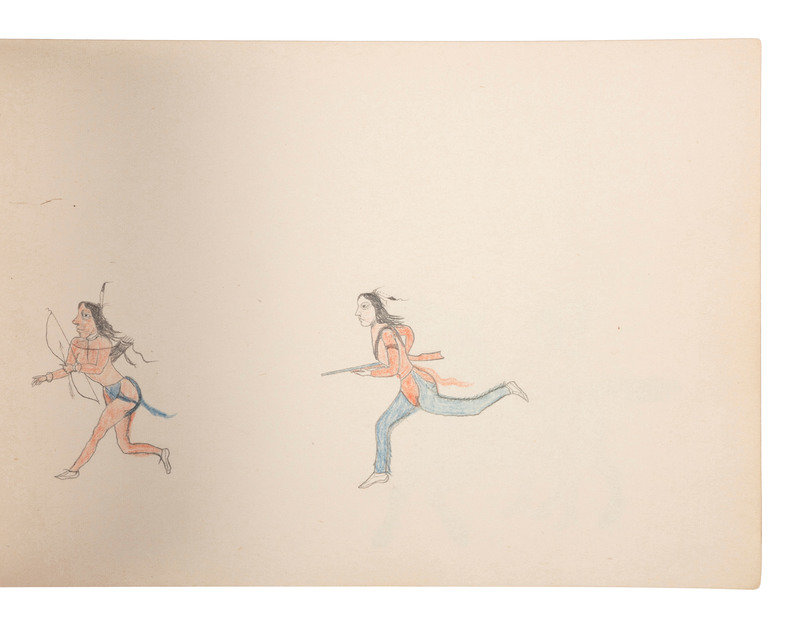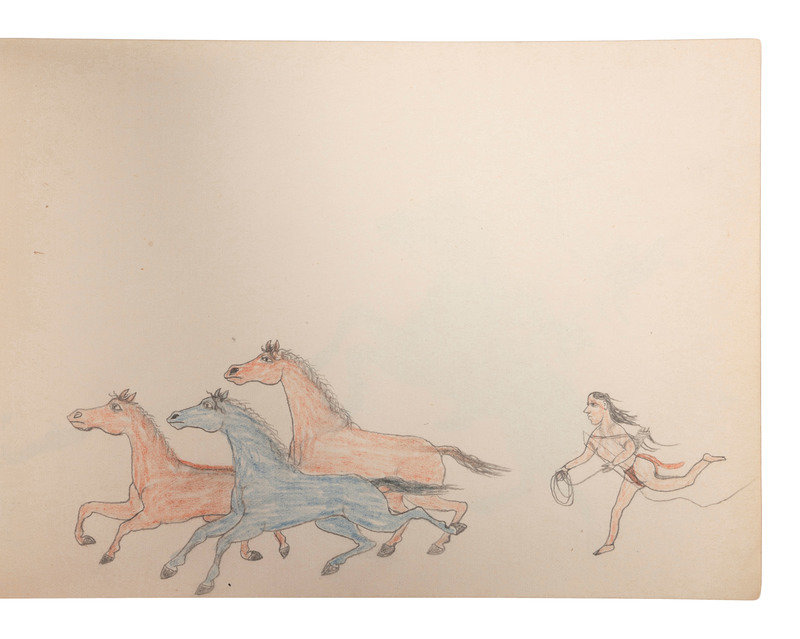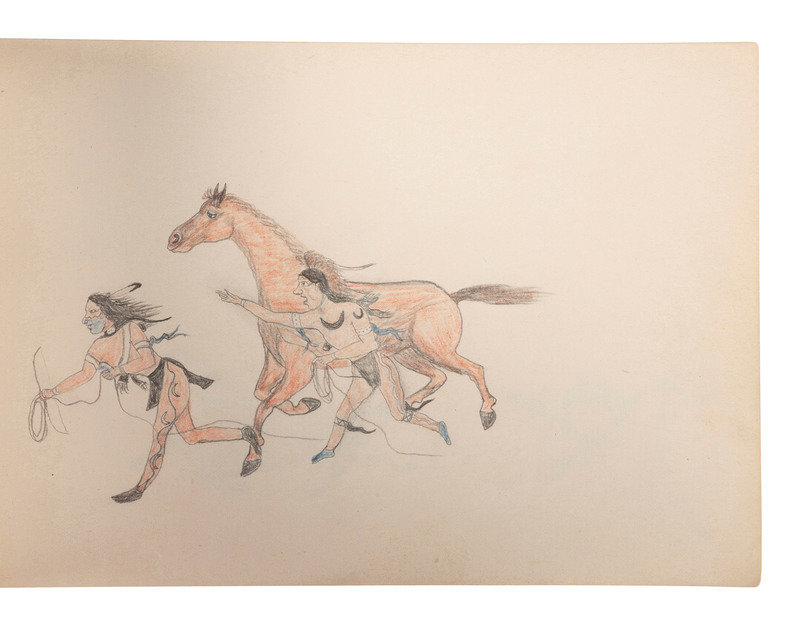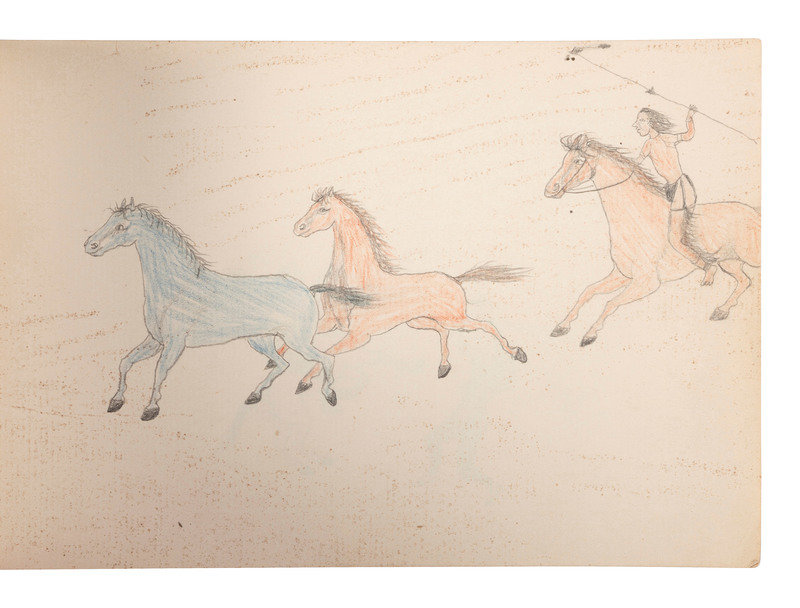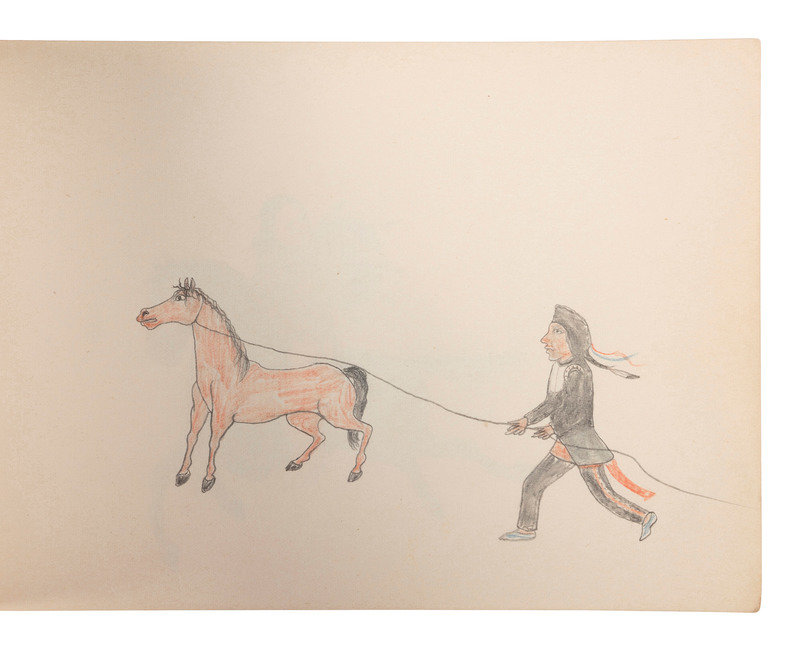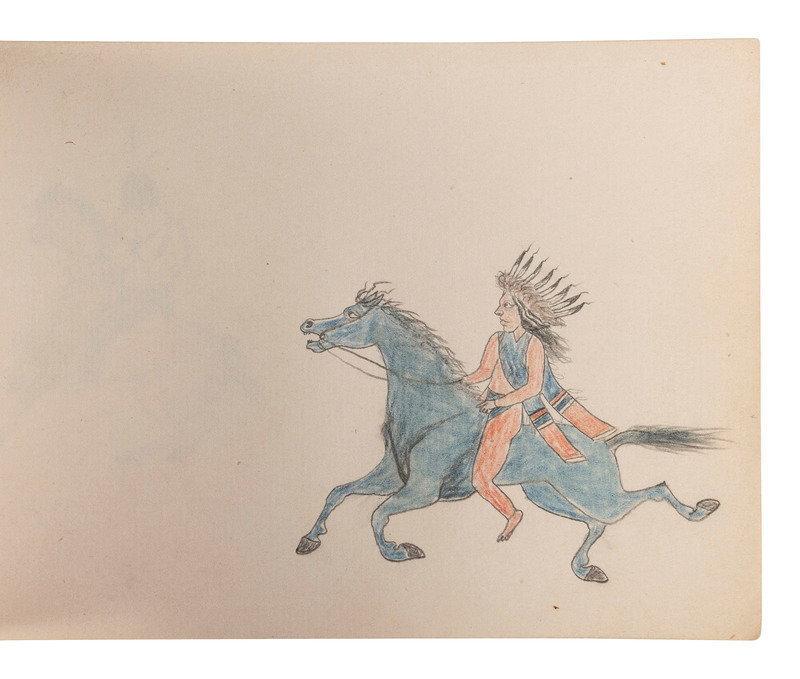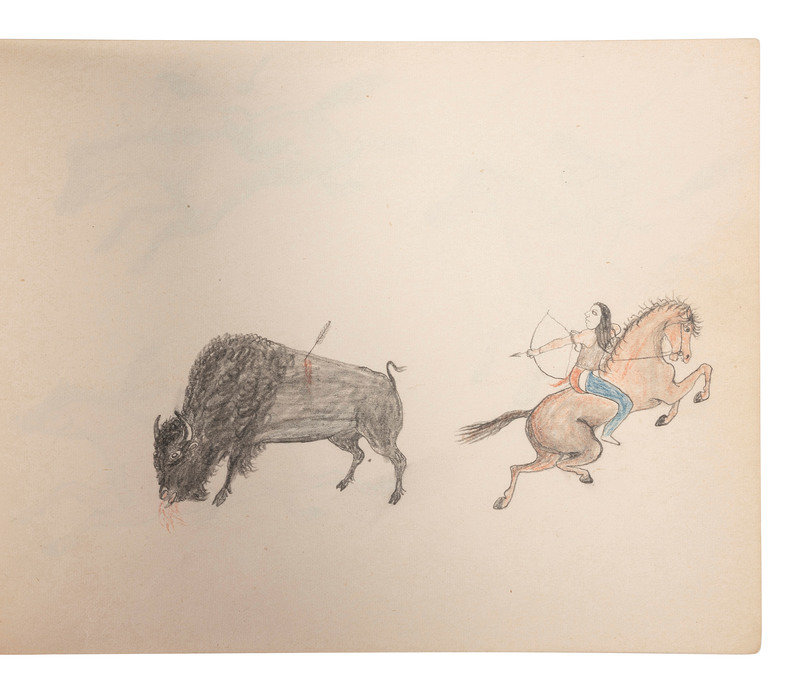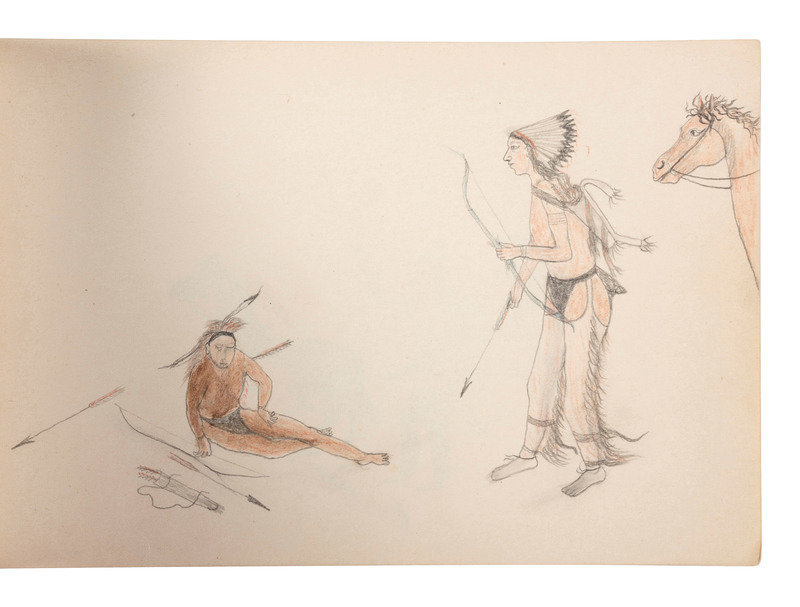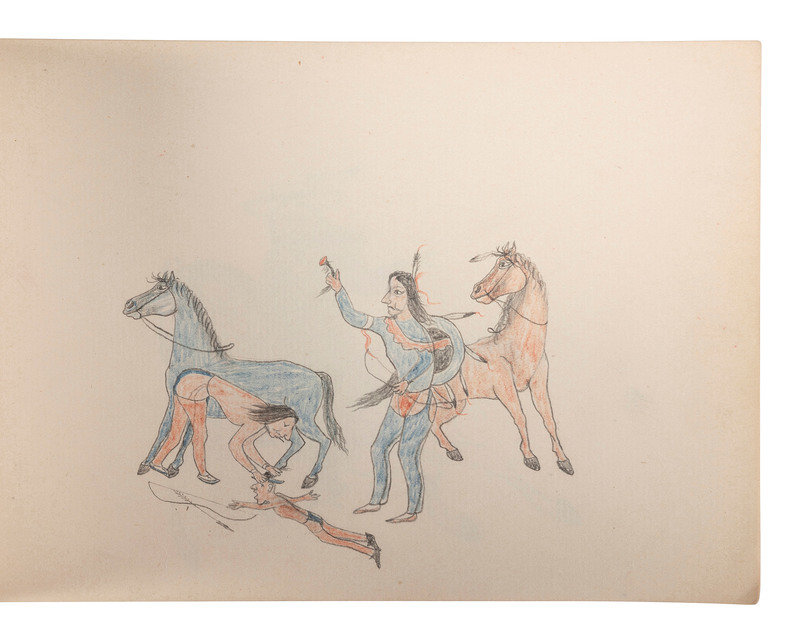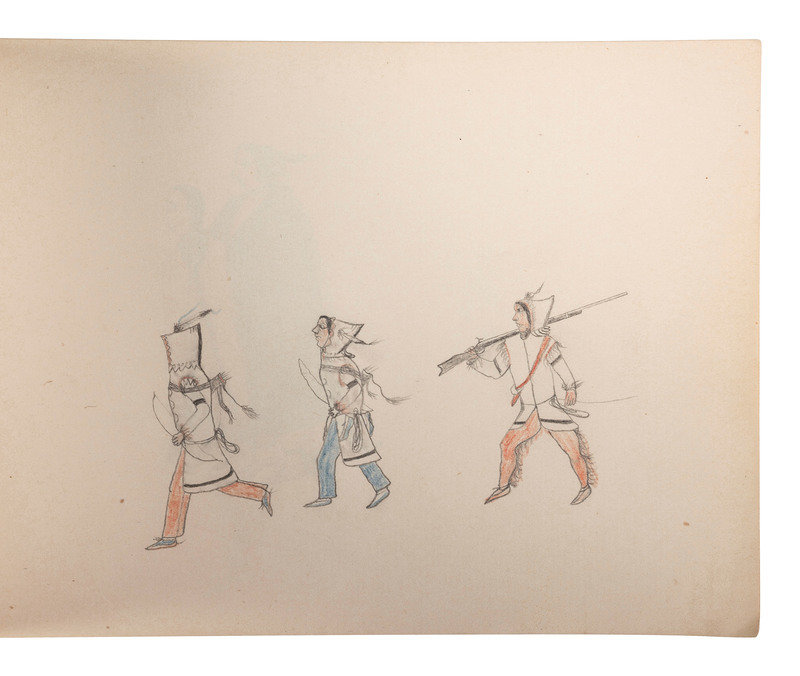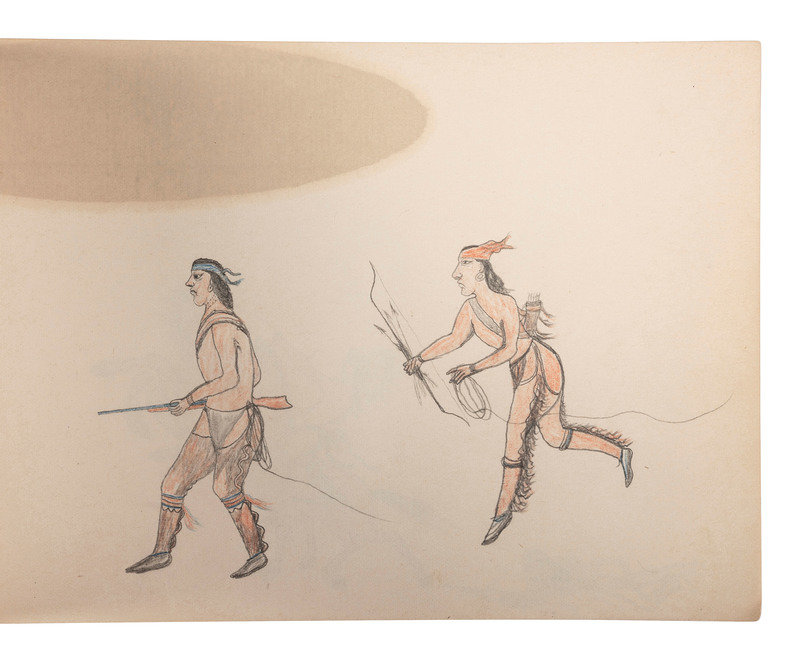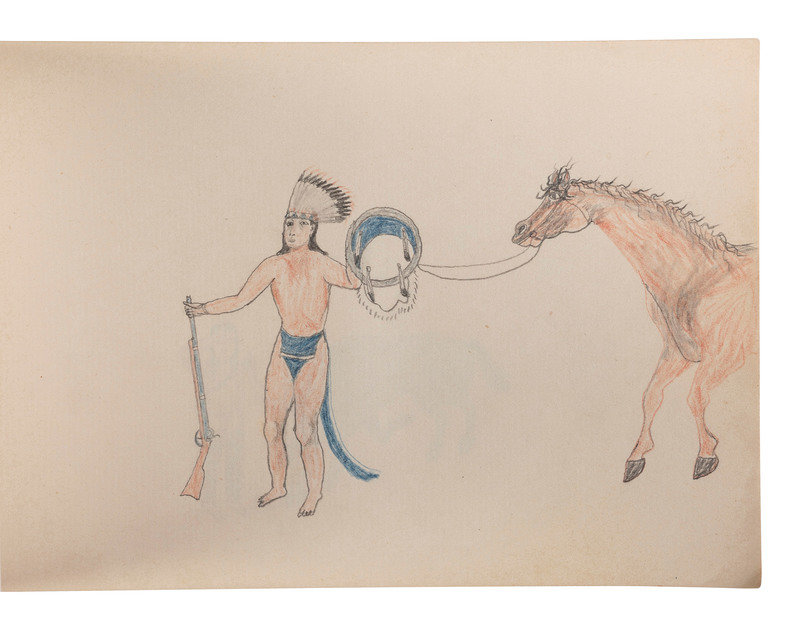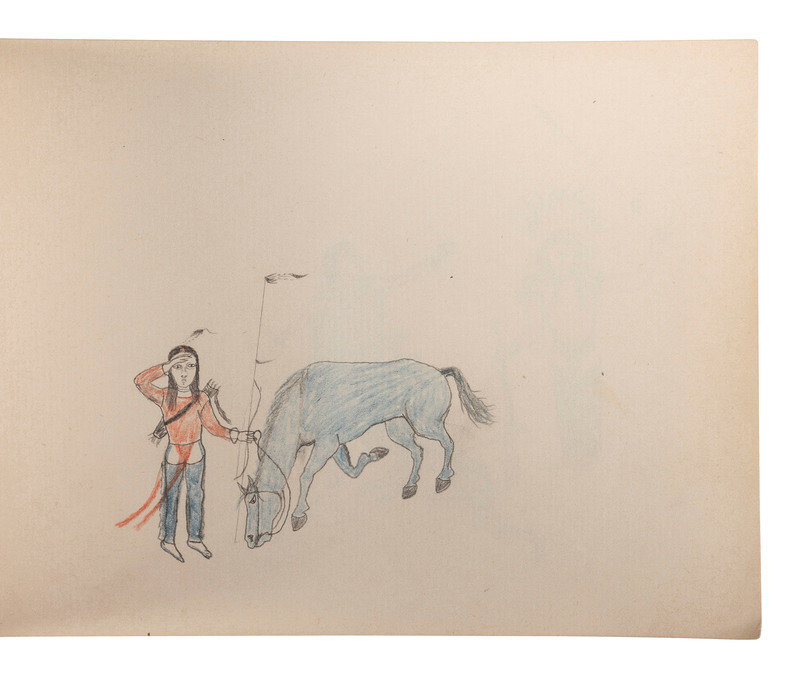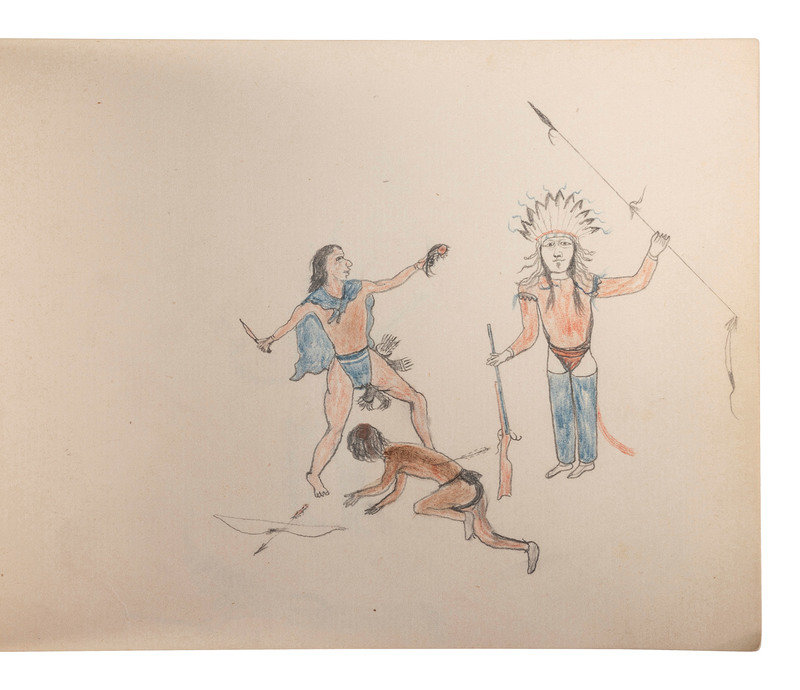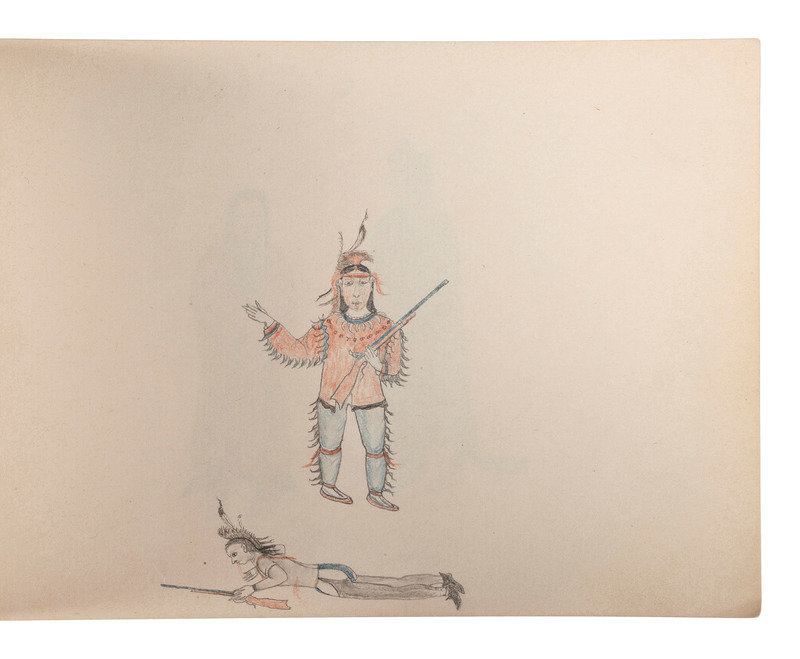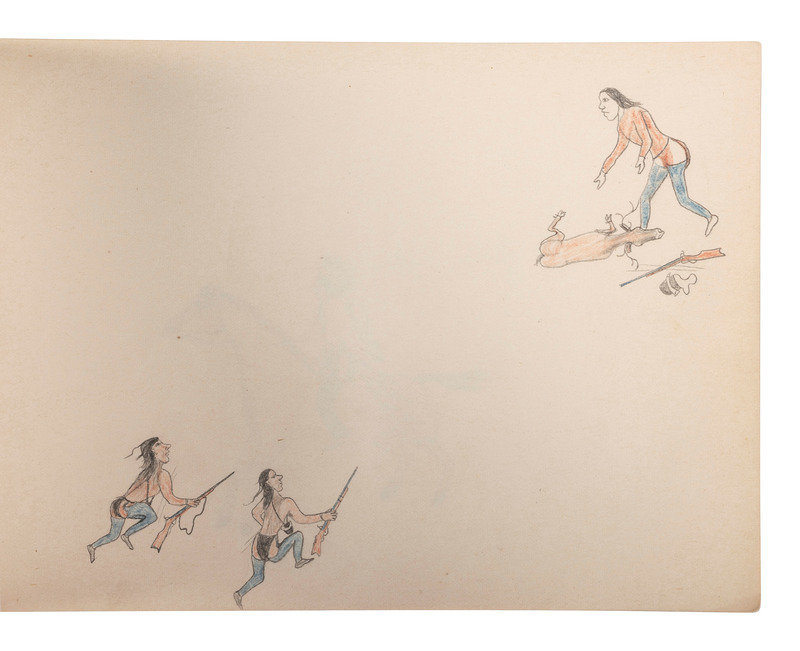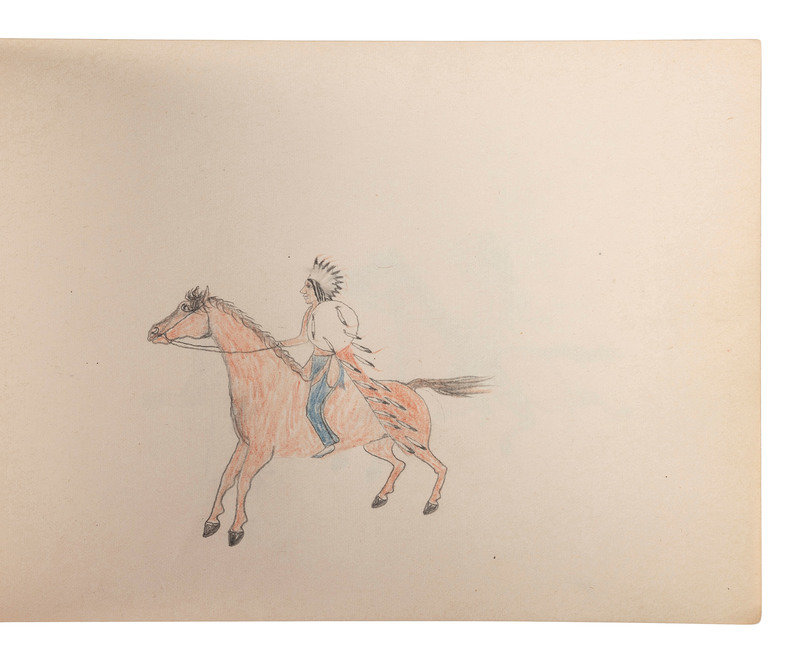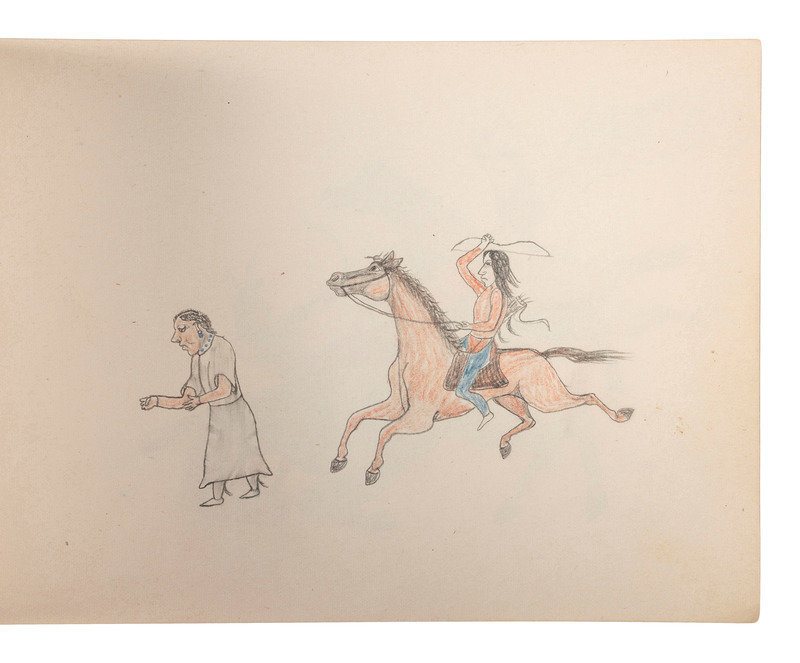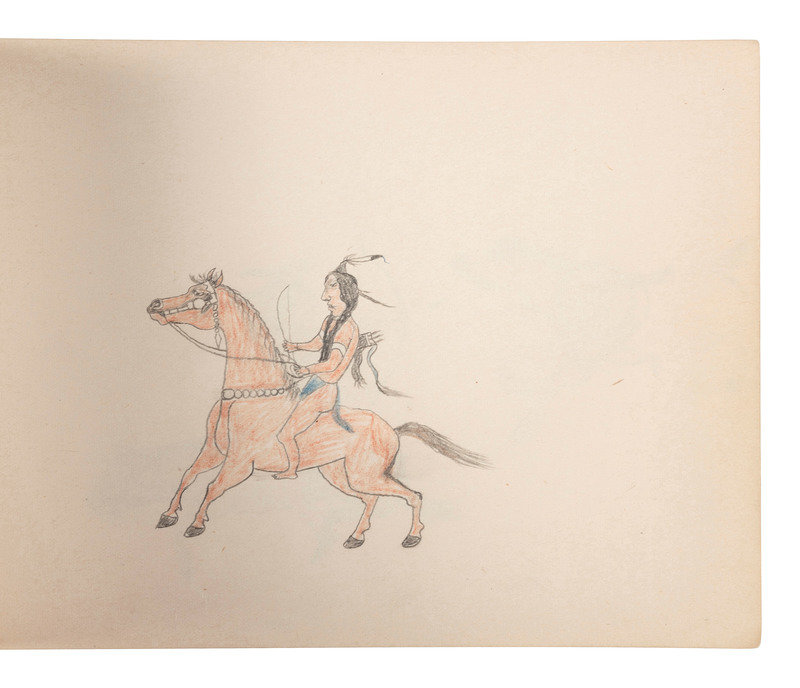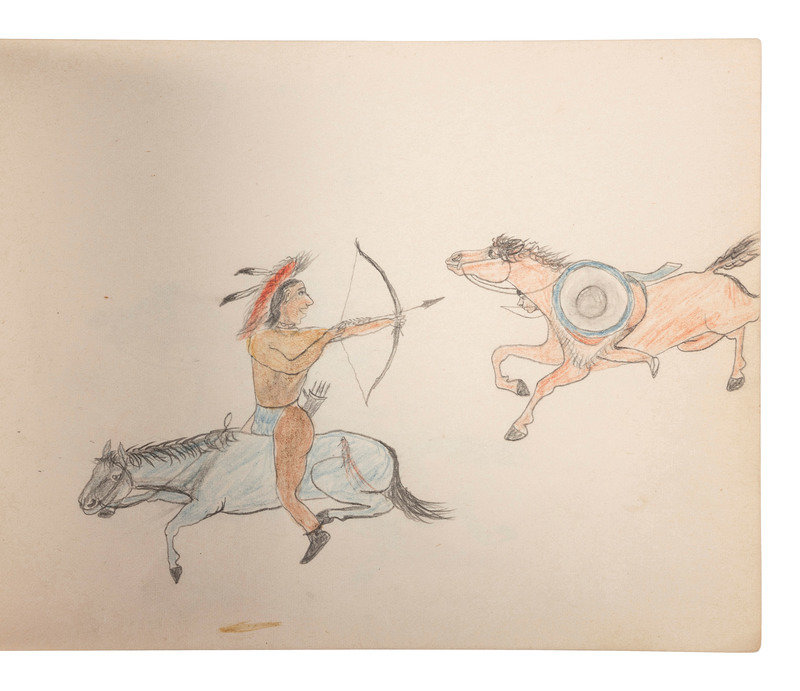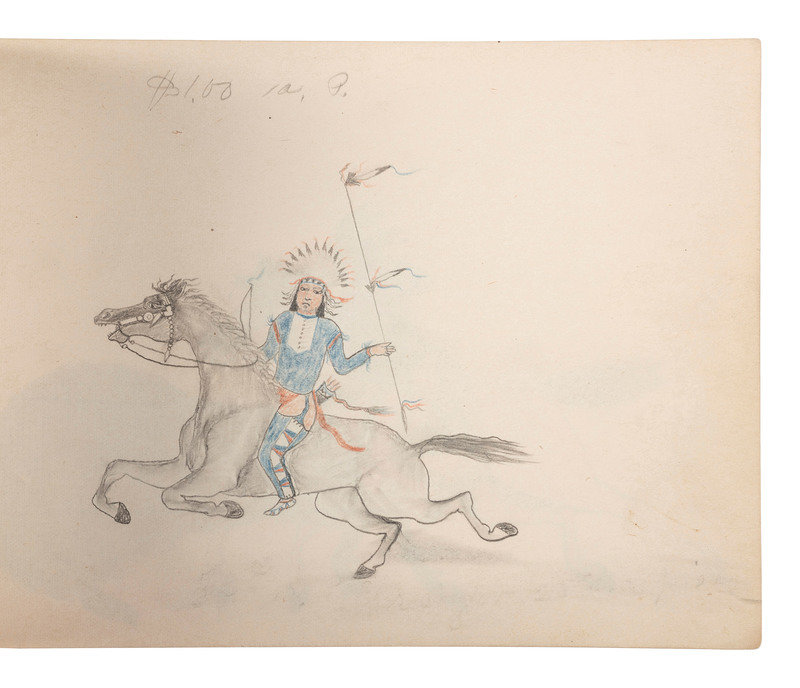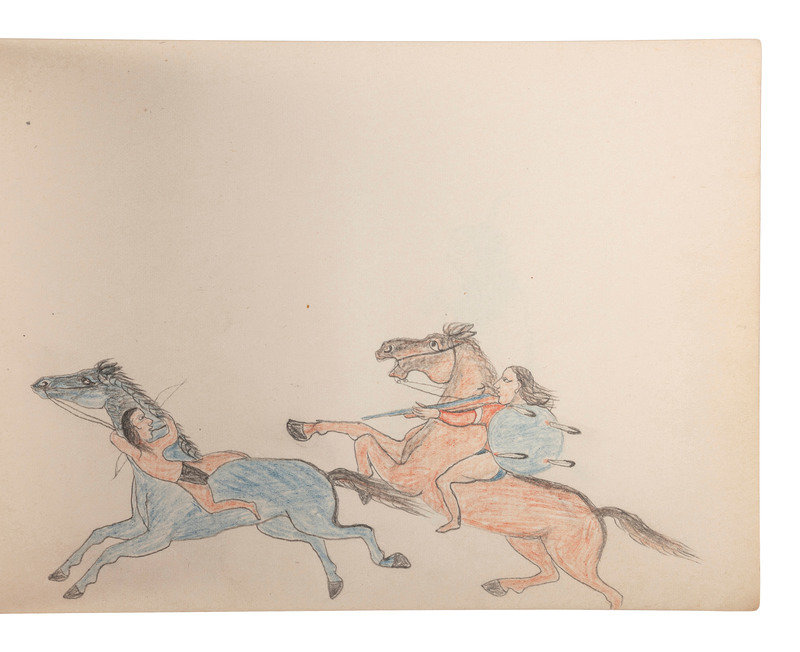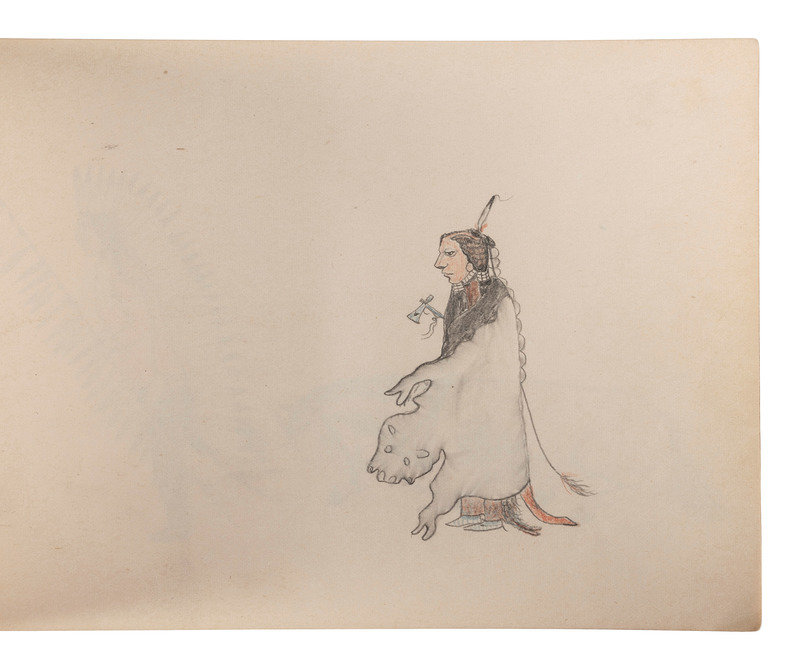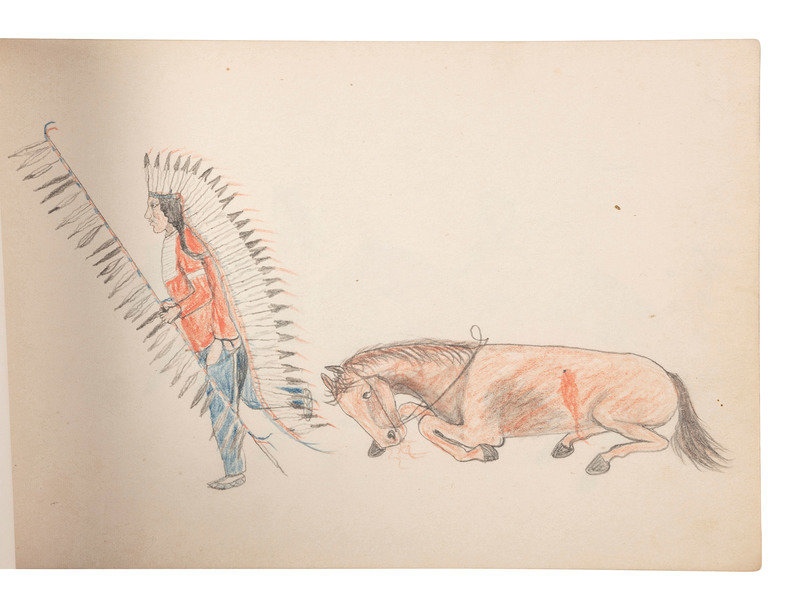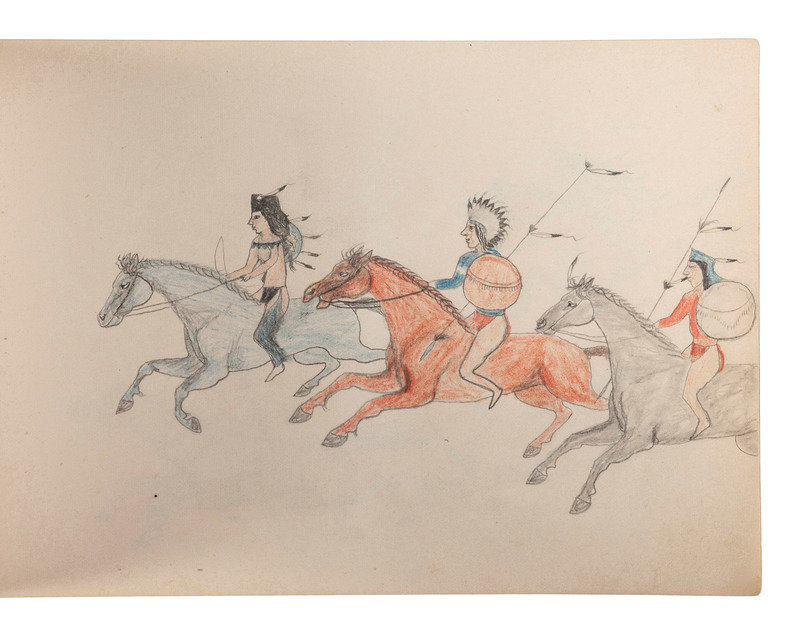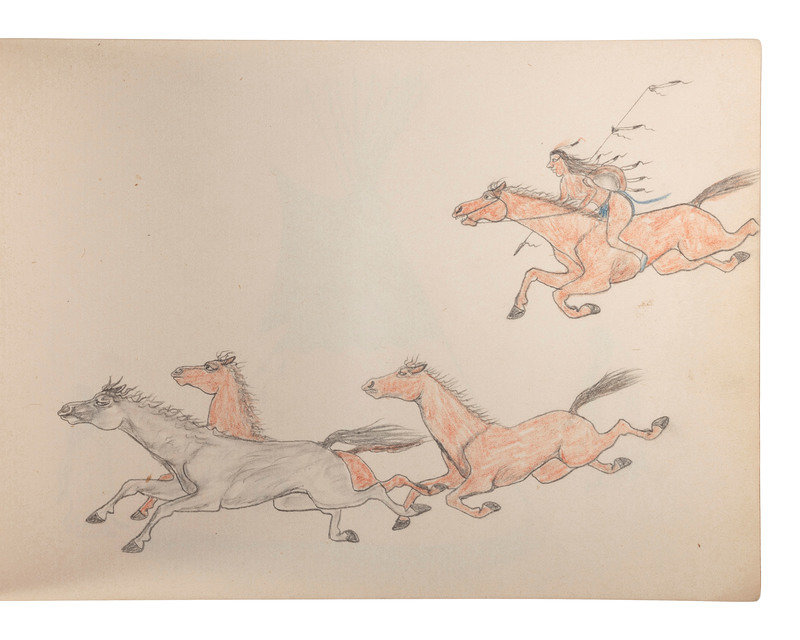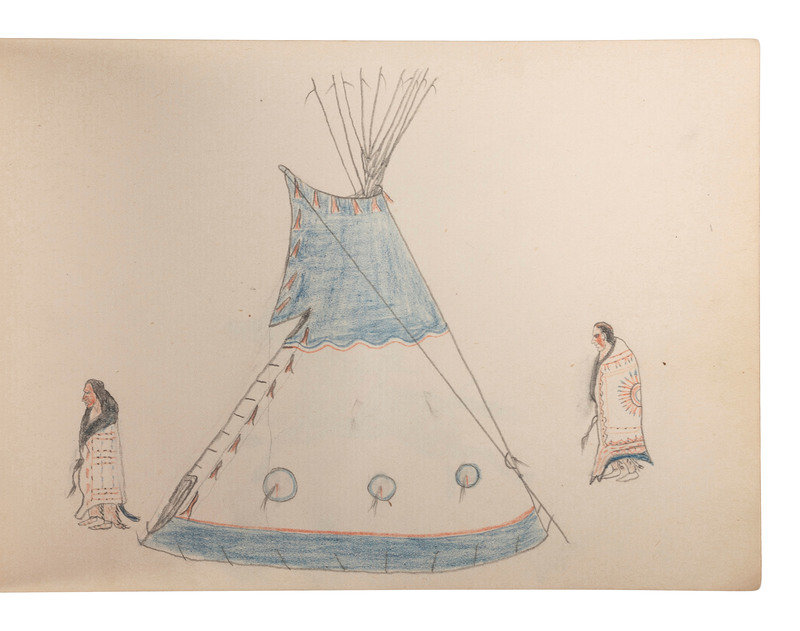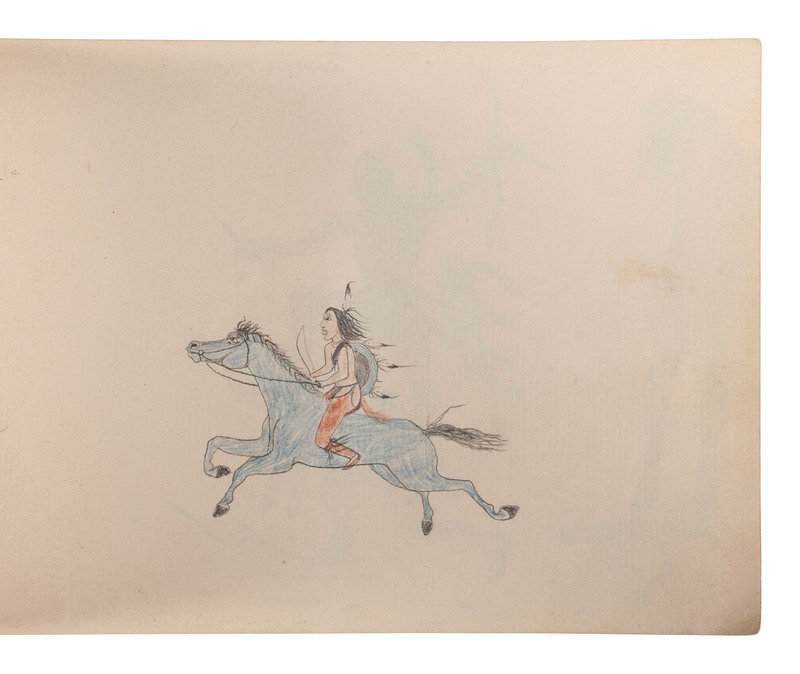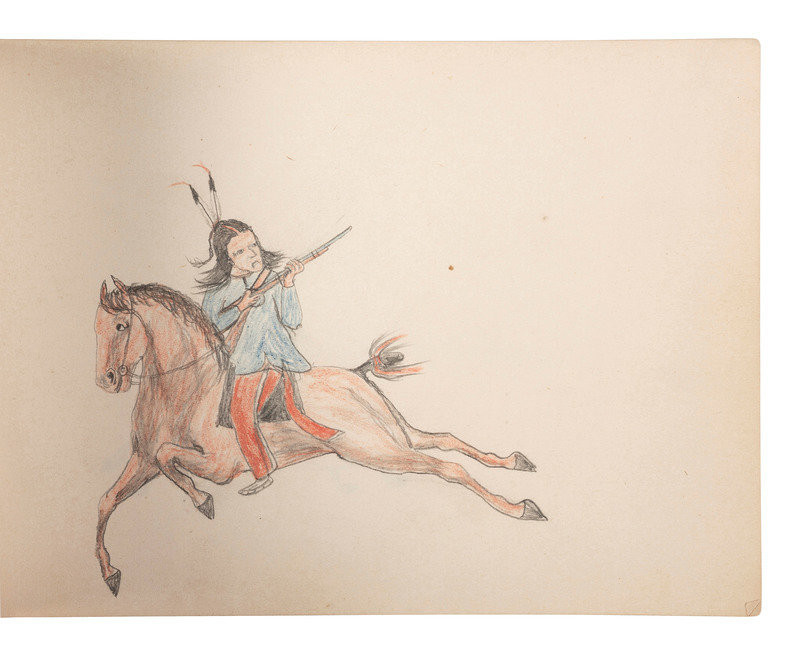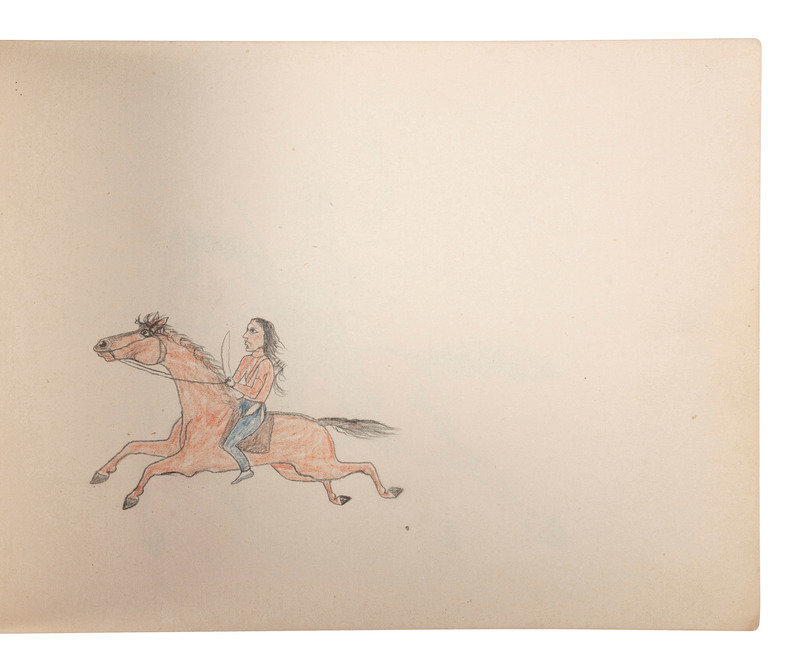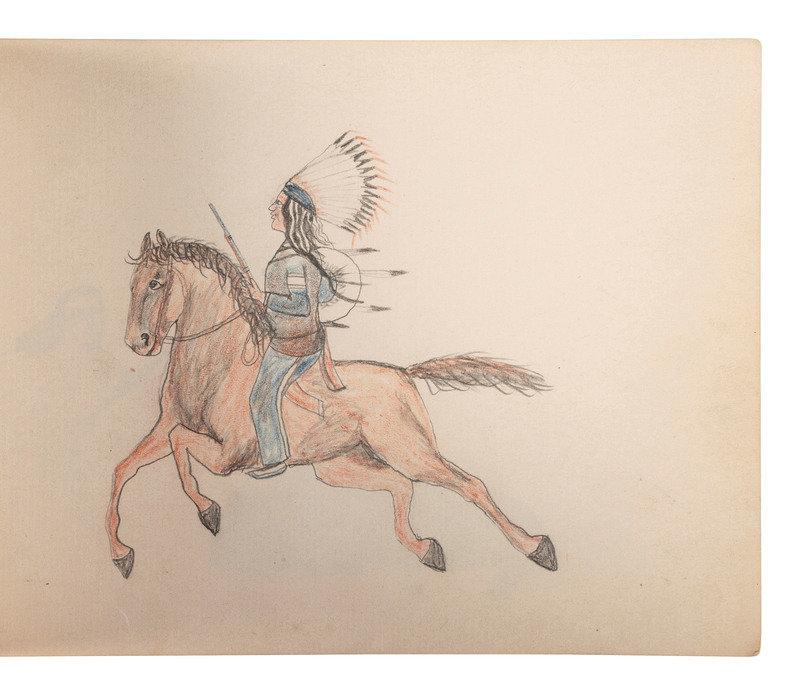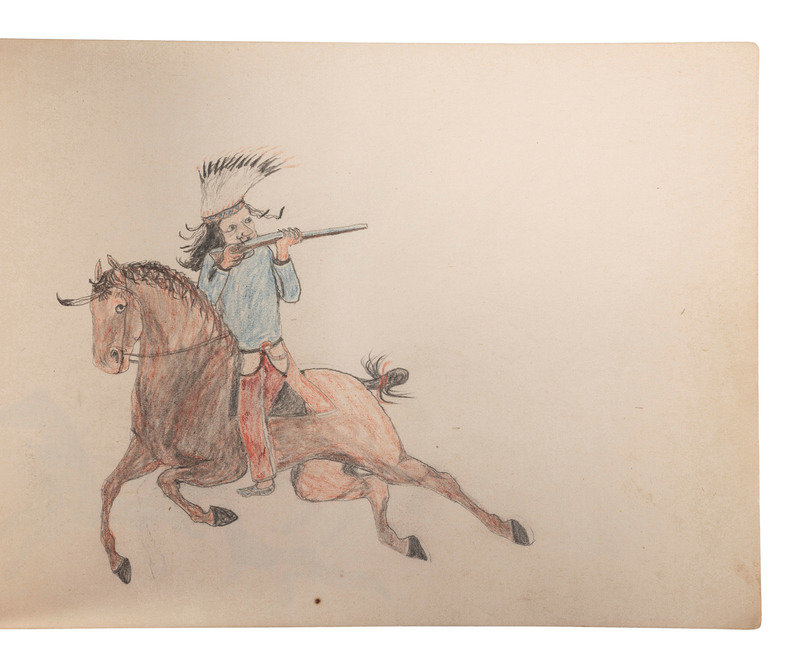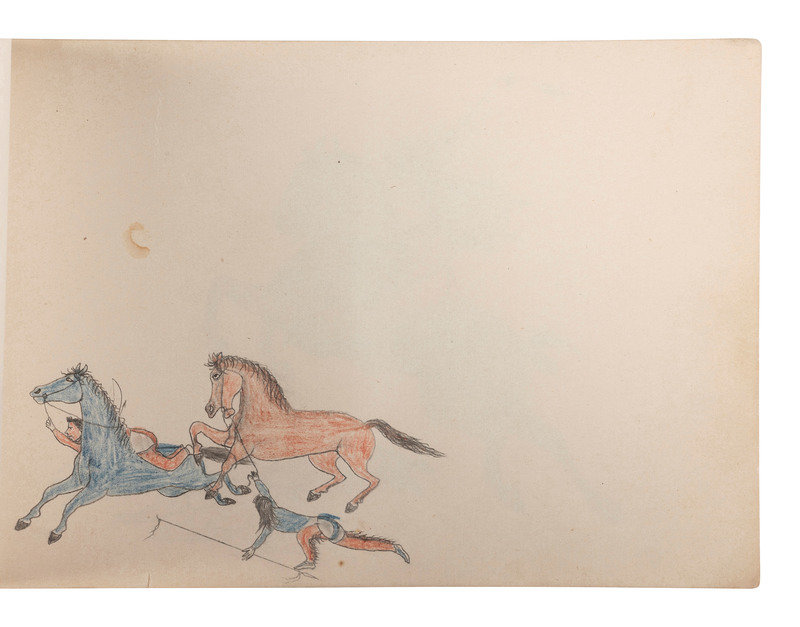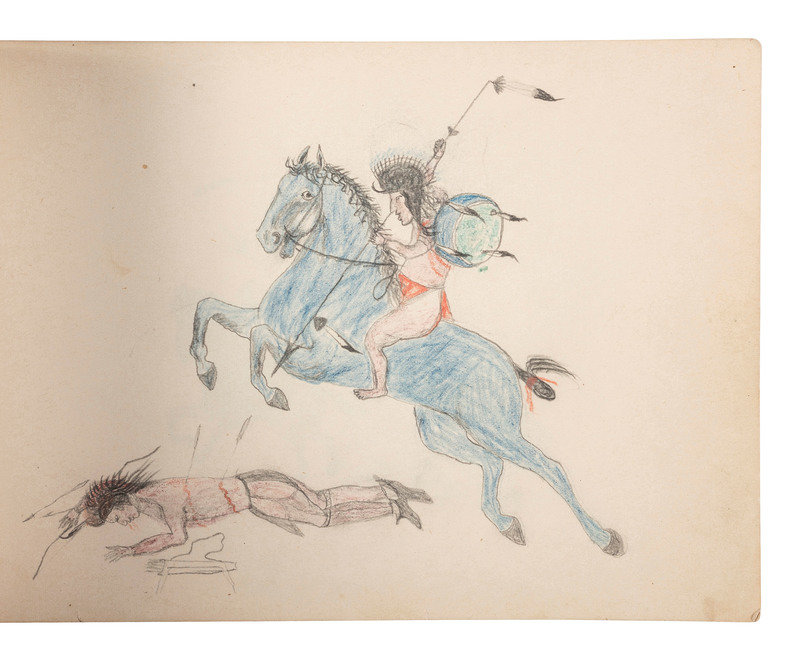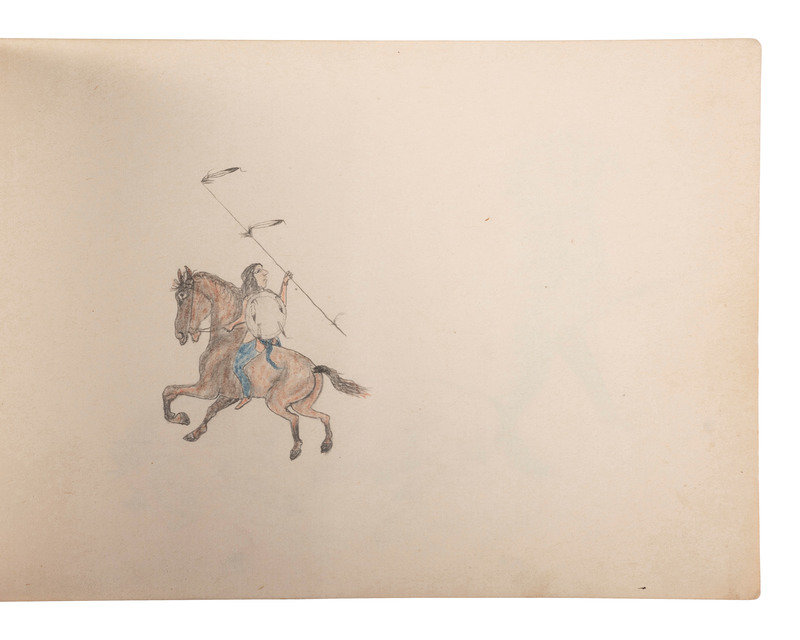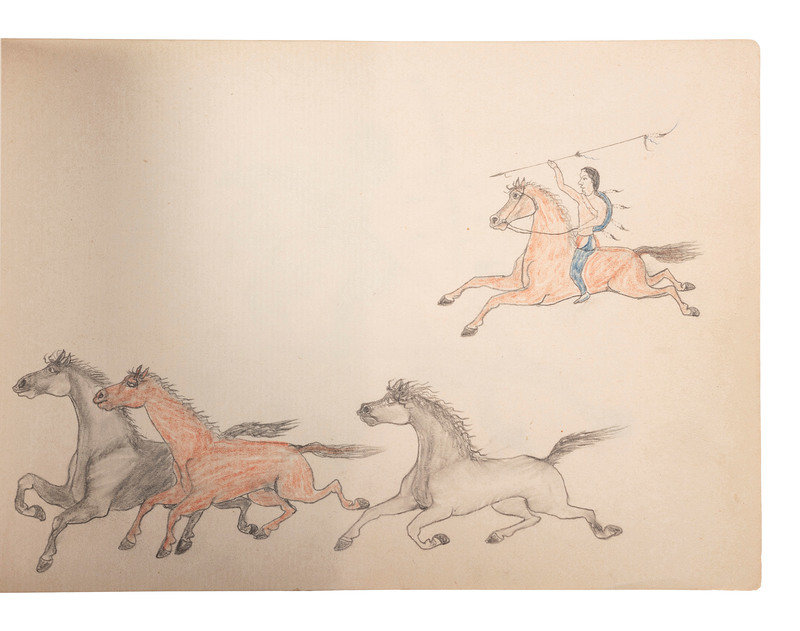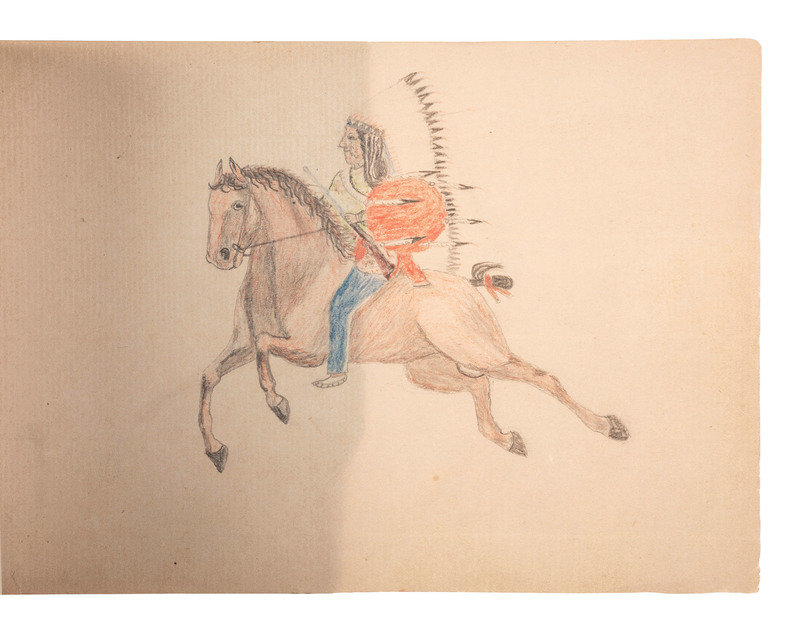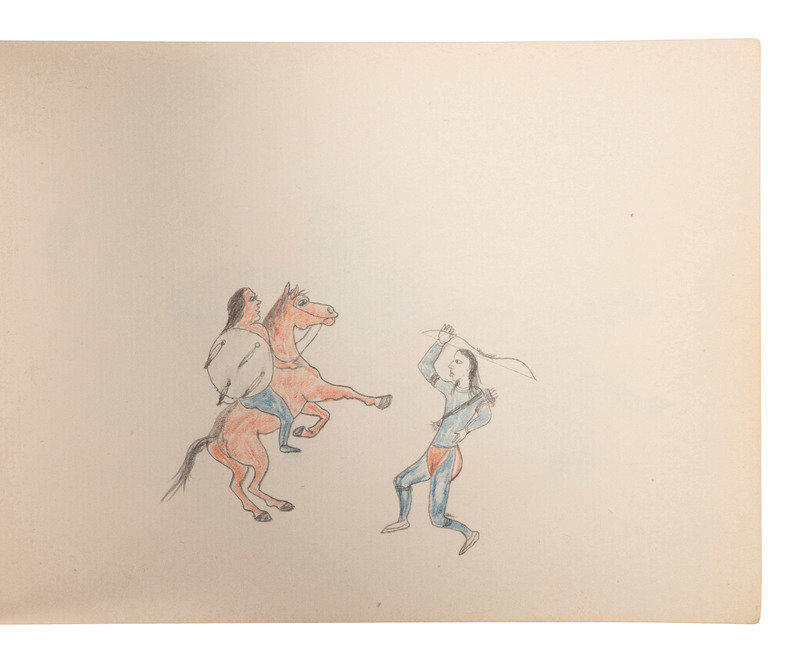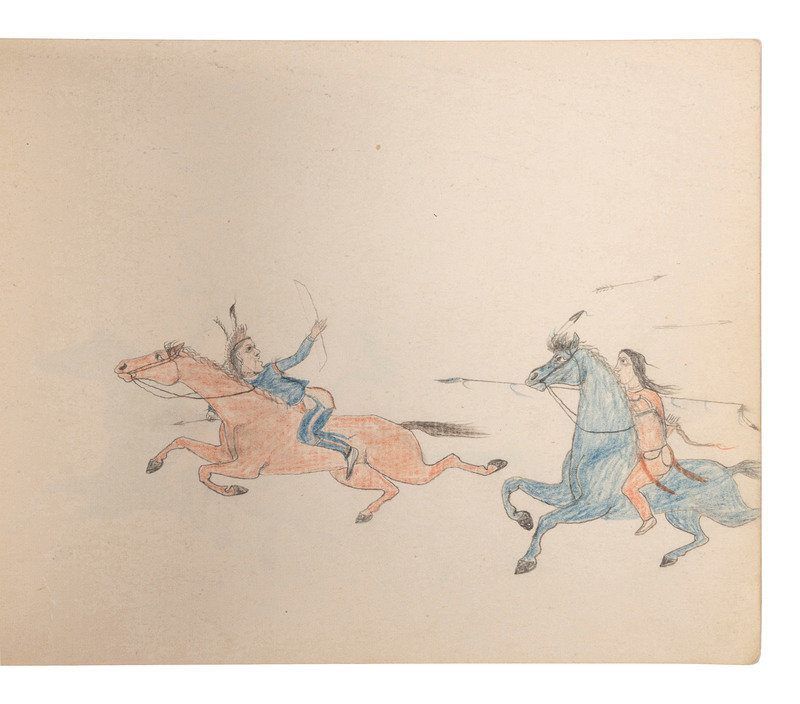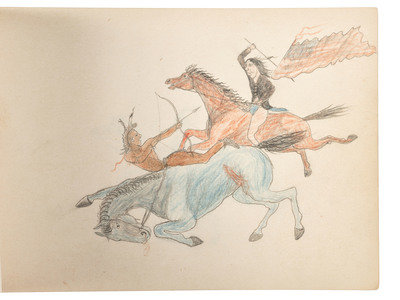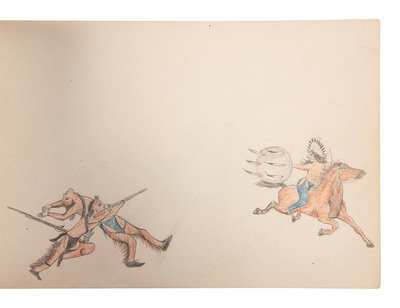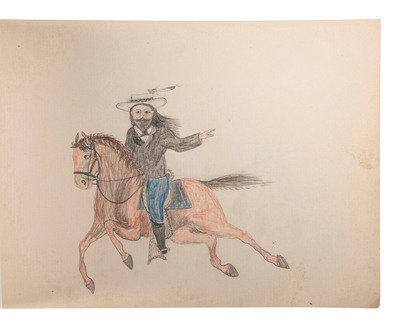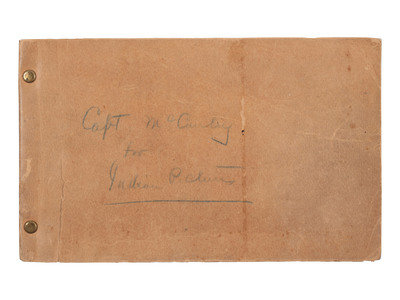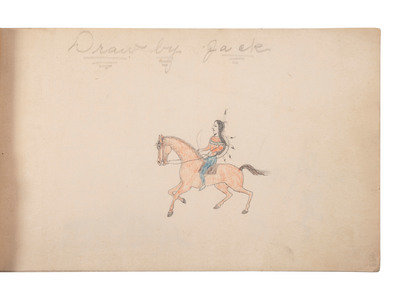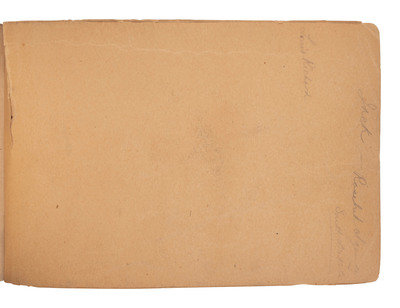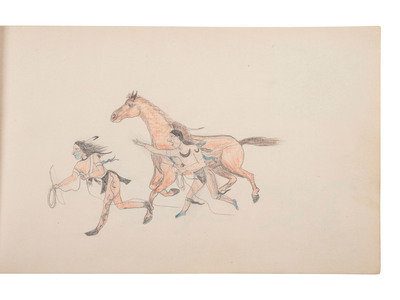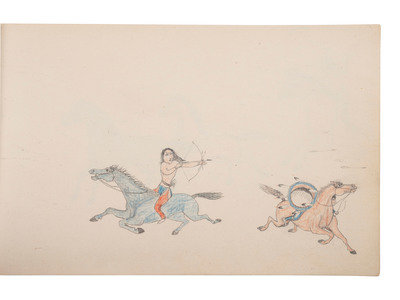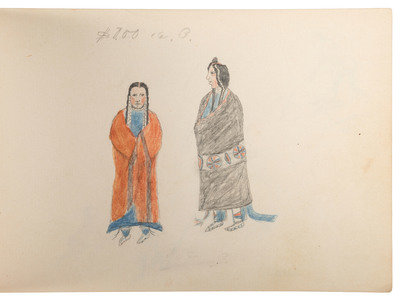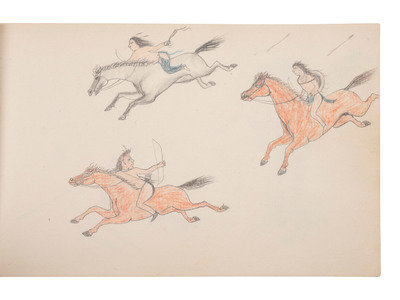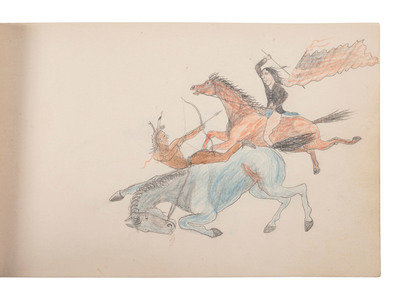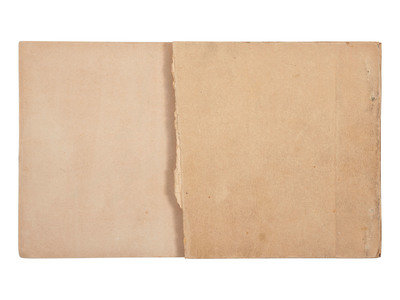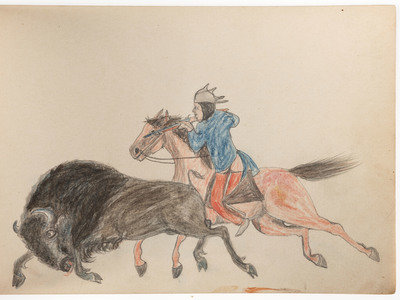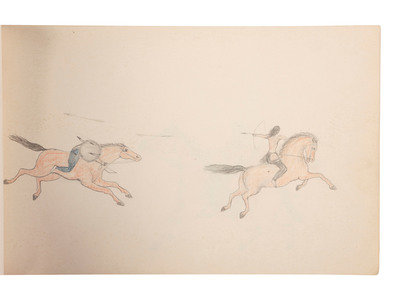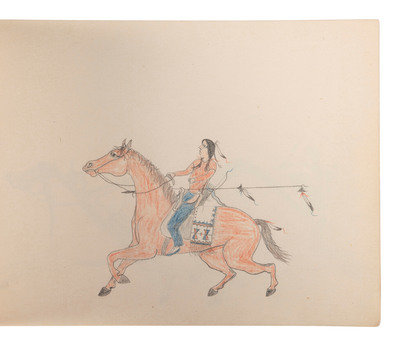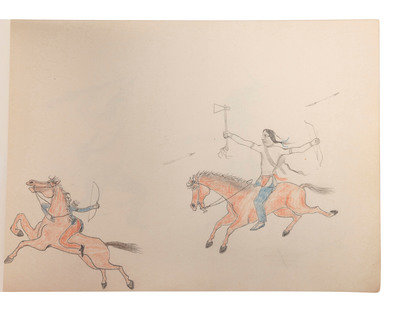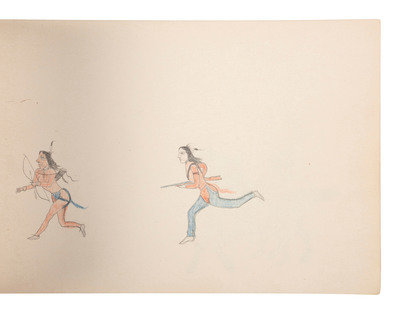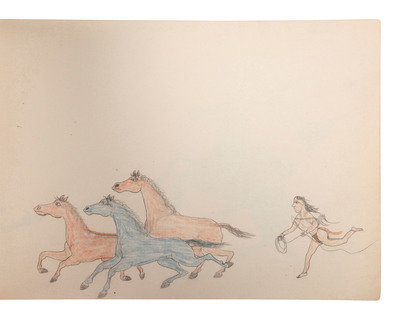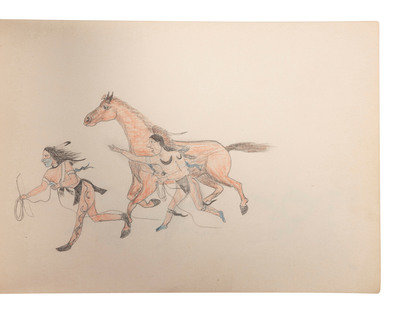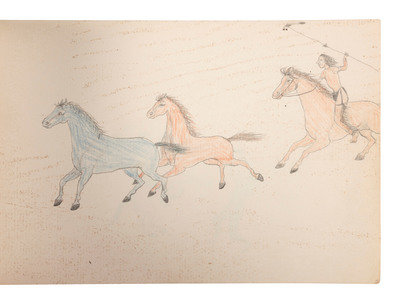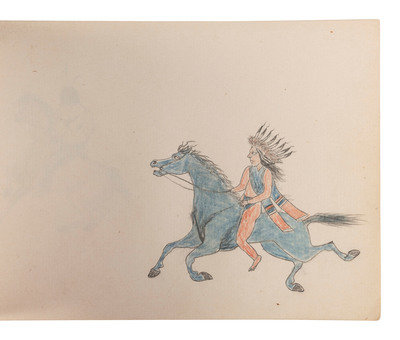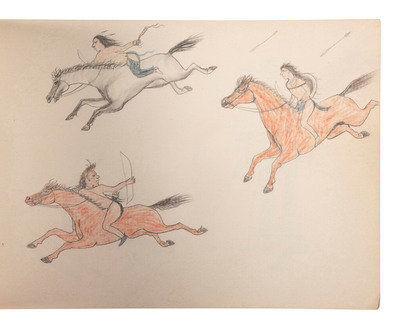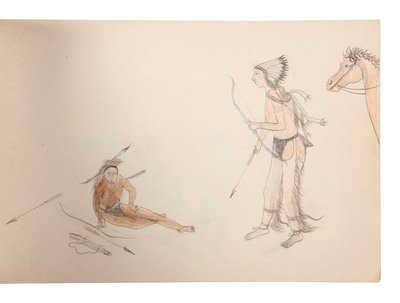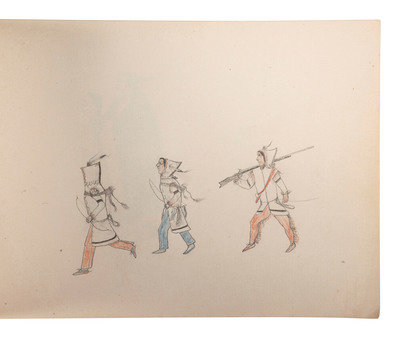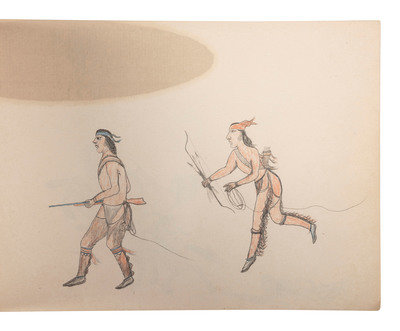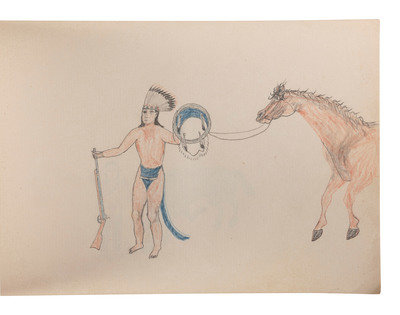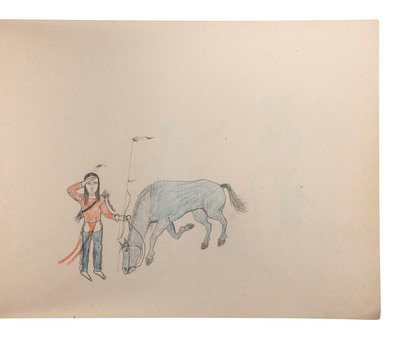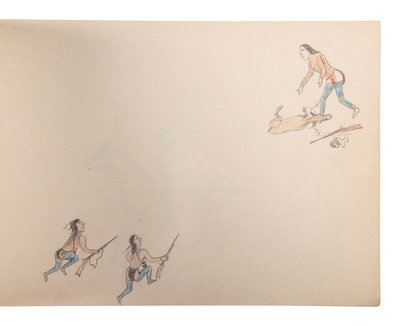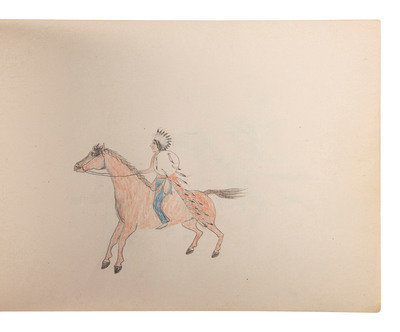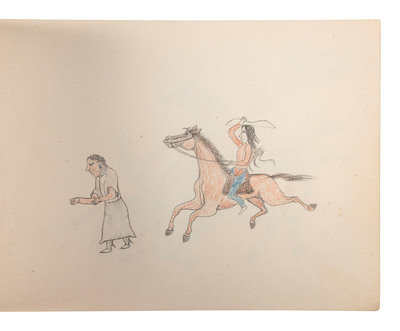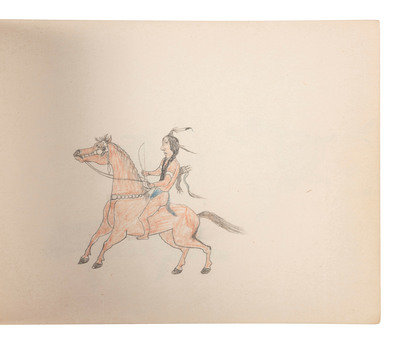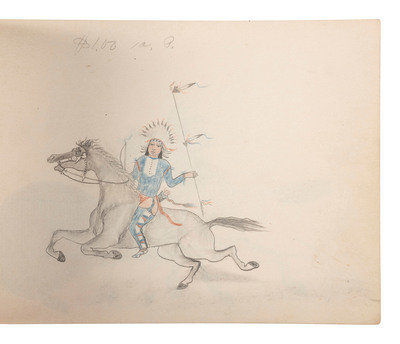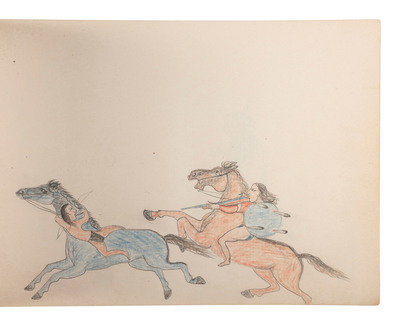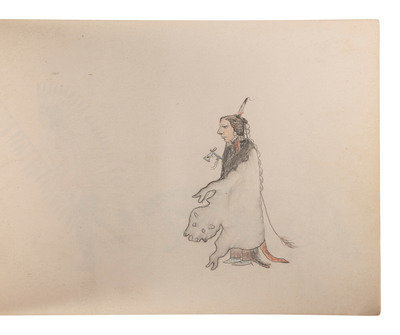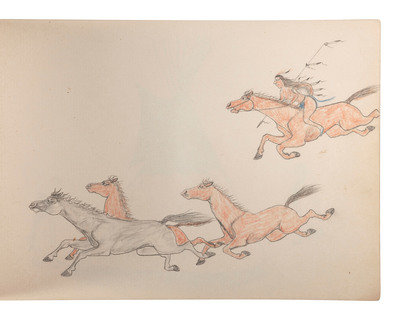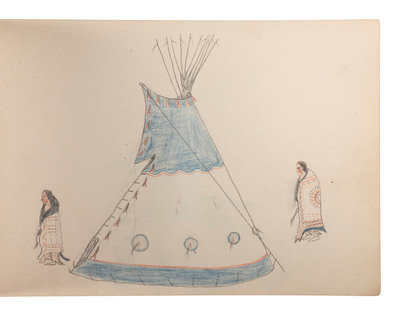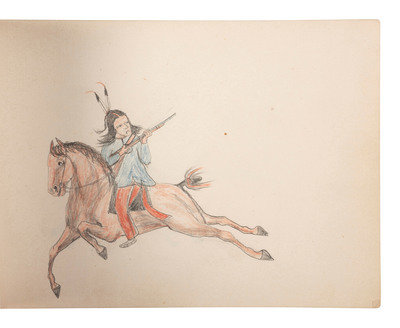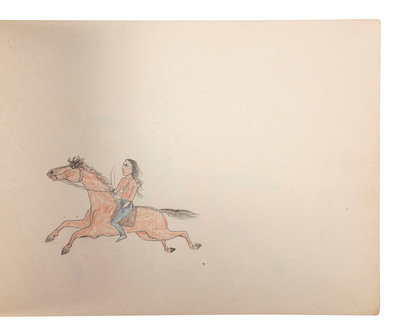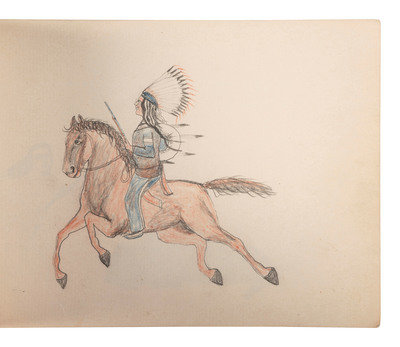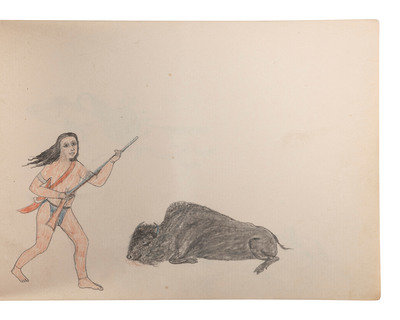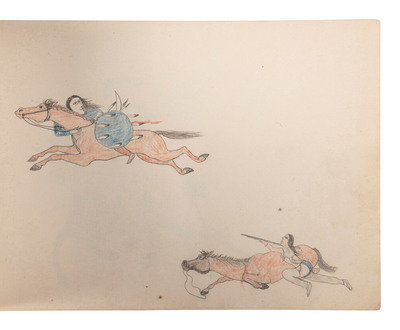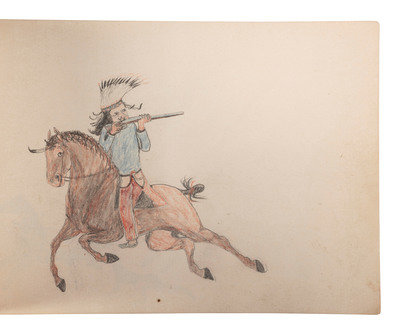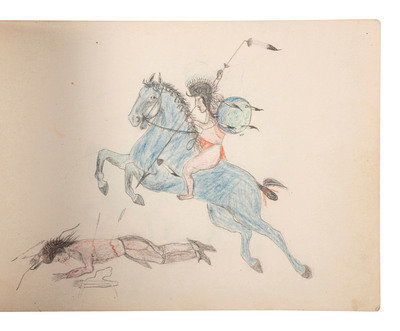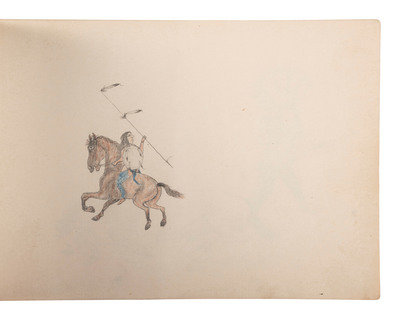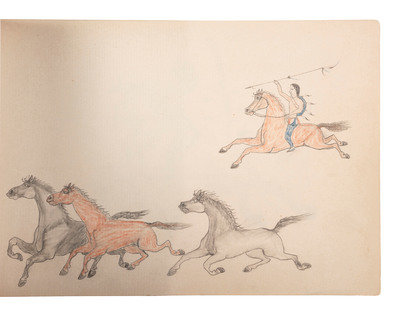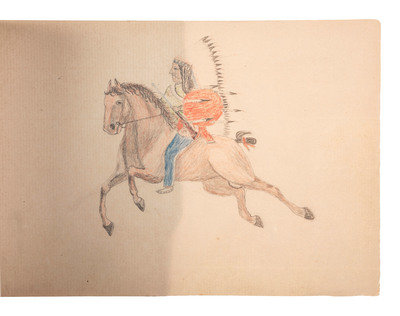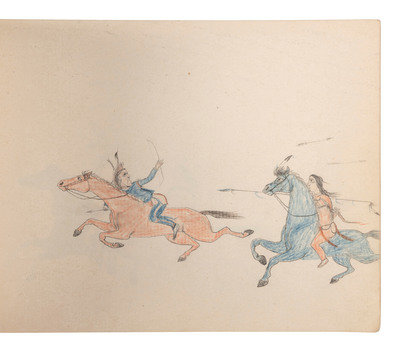9 x 5 1/2 inch sketchbook containing 72 illustrations on unlined paper, in color pencil, ca 1880s-1890s. Paper cover featuring blue pencil inscription "Capt McCauley for Indian Pictures" with additional inscriptions on reverse, "Jack - Rosebud Agency / South Dakota" and "Louis Richard." The artist is again identified on the first page which bears the pencil header "Draw [sic] by Jack" above the illustration.
Provenance: By descent directly through the family of Captain (later Colonel) Charles A.H. McCauley to the present owner, Col. McCauley's great-grandson.
The sketchbook illustrations are typical of Plains ledger art originating in the last quarter of the nineteenth-century, particularly in subject matter. Stylistically, the drawings are in a mannerist-romantic style, possessing a three-dimensionality and sense of movement that is somewhat atypical of earlier ledger drawings and is notably striking in appearance. Engaging vignettes depict warriors in graphic battle exploits, horse theft, buffalo hunts, courtship, and, in one instance, portray a European-American on horseback.
By the 1880s Native American artists across the Great Plains were making ledger art specifically for sale to the European-American middle class. Several pencil notations indicating prices such as "$1.25 a piece" and "$1.00 a.[?] p." seem to indicate that the illustrations in this sketchbook may have been intended for individual sale on behalf of the artist "Jack," perhaps by Captain Charles A.H. McCauley, the U.S. Army officer identified on the sketchbook cover. McCauley may also have provided the sketchbook and drawing utensils to "Jack" (and possibly "Louis Richard") for the express purpose of creating these drawings, as was common for military officers, traders, missionaries, and government agents to do during this period. McCauley's personal relationship to the artist "Jack" and to "Louis Richard" is not documented, though it may stem from McCauley's military service in the Wyoming Territory.
Charles Adam Hoke McCauley (1847-1913) graduated West Point in 1870 and embarked upon a lengthy military career which included extensive service in the American West. McCauley was with the Survey of the Red River in Texas (1876); was in charge of San Juan Reconnaissance, Southwest Colorado and New Mexico (1877); and was with the Ute Indian Commission in Colorado and Utah (1878). From 1879-1882 McCauley was on frontier duty at Fort Steele, Wyoming, a remote army outpost in the southeast corner of the state, before taking charge of the supply depot at Rawlins, Wyoming Territory, just a short distance from Fort Steele and less than 100 miles from Fort Laramie. It was while serving in Wyoming that McCauley was appointed Captain and Assistant Quartermaster in the Quartermaster's Department in February 1881, a rank which he retained until his appointment as Lieutenant Colonel in 1895, thereby roughly dating the sketchbook to within this fourteen-year timeframe.
Though the exact identities of "Jack" and "Louis Richard" cannot be determined with absolute certainty, a search of the U.S. Indian Census Rolls and additional research seem to indicate two Sioux men as potentially having a connection to the ledger offered here. U.S. Indian Census Rolls locate both a "Jack" (no last name and no "Indian Name" included in the roll just as on the ledger) and a "Louis Richard," as residents of the Rosebud Indian Agency in 1891. "Jack" (ca 1847 - ca 1920) appears on Indian Census rolls at Rosebud Agency well into the 1900s, and is identified as "Lower Band of Brule Sioux" as well as "Yankton" and "Rosebud" Sioux. He is identified as husband to "Good White Buffalo Cow." Following the 1891 Census, "Louis Richard" (ca 1843 - ca 1897) is located instead at Pine Ridge Agency from 1892 through 1897. He is identified as "Sioux and Cheyenne" and of "Mixed Band of Brule Sioux," and husband to "Jennie Richard."
Though additional details on "Jack" are elusive, "Louis Richard" may well be Louis Francis Richard (Reshaw), a mixed-race U.S. Army Scout and interpreter with longstanding connections to southeast Wyoming and the U.S. military. Richard's mother was Marie Gardinear (ca 1827-?), the mixed-race daughter of a trapper and White Thunder Woman, a relative of Red Cloud. Richard's father was John (Jean) Baptiste Richard (ca 1810-1875), a trapper, trader, and entrepreneur of French ancestry. John Richard established multiple toll bridges over the North Platte River, and one across the Laramie River within the Fort Laramie military reservation. During the decades leading up to the 1870s, John Richard and his family were well-known to the U.S. Army. Louis Richard may have been in charge of affairs at his father's old trading post at the "Old North Platte Bridge, or California Crossing, 120 miles west of Fort Laramie" in 1866, but by 1868 he was already employed by the government as an interpreter during the Fort Laramie Treaty ("Indian Peace Commission") proceedings. A veteran scout, in 1876 he is documented as a United States Quartermaster Department Scout serving under General George R. Crook. Louis Richard's tombstone states that he was "a trader like [his father] and operated bridges in Wyoming as an Oglala speaker. The Army hired Louis to tell hostile members to surrender in 1876. He was a scout for General George Crook during the Rosebud Mt. battle and Power River Expedition." Col. William F. "Buffalo Bill" Cody's autobiography references Richard, noting that in 1876 the two scouts were "selected to accompany General Miles on a reconnaissance" during the U.S. Army's campaigns against the American Indian tribes of the Great Plains. Not only was Louis Richard a contemporary of Cody, but of other famed U.S. Army Scouts including Frank Grouard and Baptiste "Big Bat" Pourier, who was Louis Richard's brother-in-law. In the years following the Great Sioux War of 1876, Louis Richard appears to have remained in the service of the U.S. government as an interpreter, including on 1880 negotiations between the Sioux at Pine Ridge and Rosebud Agencies and the Chicago, Milwaukee and St. Paul Railway Company. It is during this post-war time period that Richard's service with the U.S. military may have overlapped with Captain McCauley who was stationed in Wyoming from 1879-1882. McCauley's position in the Quartermaster's Department may have served as an introduction to Louis Richard, as at the time Army quartermasters hired individuals for jobs such as scouts, guides, and interpreters.
A 6 November 1882 agreement related to the receipt of rations and annuities at Rosebud Agency in the Territory of Dakota bears the name of "Louis Richard" indicating that the scout had departed Wyoming Territory at that time. It is uncertain how or if he returned to Wyoming once he had assumed residence at Rosebud Agency. This same agreement was witnessed and signed at Rosebud Agency by "Jack Stead," perhaps the same Jack Stead who served as a U.S. Army Scout in Wyoming and was an associate of both Louis Richard and William F. Cody while in the service of the U.S. military. Though Jack Stead seems to be a less likely candidate for the artist "Jack," the army scout connections between Jack Stead and Louis Richard solidify the need to explore other potential individuals who may in fact be the creator of the drawings in this ledger. Additional research will necessarily shed light on these associations, and open avenues of inquiry towards identifying "Jack" and "Louis Richard" with certainty.
Regardless of the identities of the artists, the illustrations themselves represent an important and historic visual record which memorializes bravery, battle, and a receding way of life. Bound with two fasteners, the drawings offer a glimpse into pre-reservation Plains Native culture. Drawings illustrate a time when warriors hunted buffalo instead of receiving rations, when tipis were home instead of Anglo-American cabins, and when warriors proudly fought and subdued their enemies. The ledger features more than 30 illustrations of warriors actively engaged in battle, with the remaining illustrations featuring scenes of braves hunting buffalo, capturing horses, engaged in courtship, and other scenes of life on the Plains. Only one image portrays a European-American. The individual pictured, with his military-style pants, jacket, and distinctive facial hair, bears a remarkable likeness to William F. Cody. The potential for the image to be Cody is strong, as Cody and Louis Richard served as scouts together under General Crook (the two were photographed together ca 1870, see Smithsonian Institution, NAA INV.01600906, James E. Taylor scrapbook of the American West). By the 1880s Cody was well-known to the inhabitants of both Rosebud and Pine Ridge Agencies where he actively recruited for his "Wild West Show." At the time Cody's show travelled to London for the first time in 1887, Cody was almost exclusively hiring Lakota, predominantly from these same two reservations in the Dakota Territory.
With fully dimensional depictions and dynamic figures, the drawings by "Jack" demonstrate meticulous attention to detail. Even more, the ledger art found in McCauley's sketchbook represents a long tradition of Native peoples of the Great Plains preserving histories pictorially. While 19th-century ledger art is rare in any form, an intact sketchbook which presumably retains the narrative order of the drawings is exceedingly scarce. A rare and significant piece of Native American Art, with important connections to the embattled history of the Great Plains Indian tribes.
Overall good condition. 2 5/8 in. vertical tear near bottom left corner on sketchbook cover, also creasing and light soil to cover. Approximately half of back paper board cover missing. Fasteners intact and drawings remain securely bound together. Drawings generally very clean and without losses or tears. Light toning and scattered spots and/or smudges throughout. One drawing with approx. 5 3/4 in. oval dampstain not affecting image.
